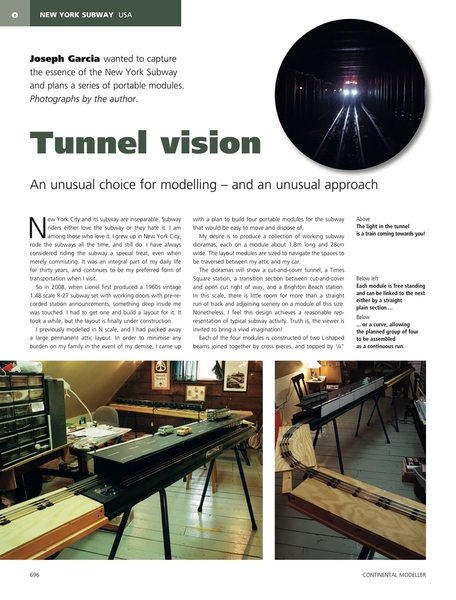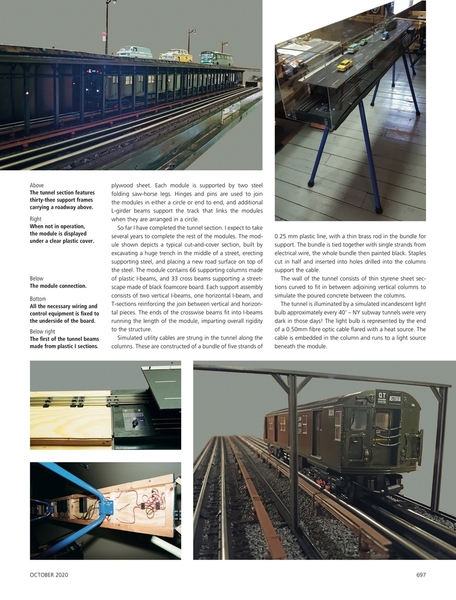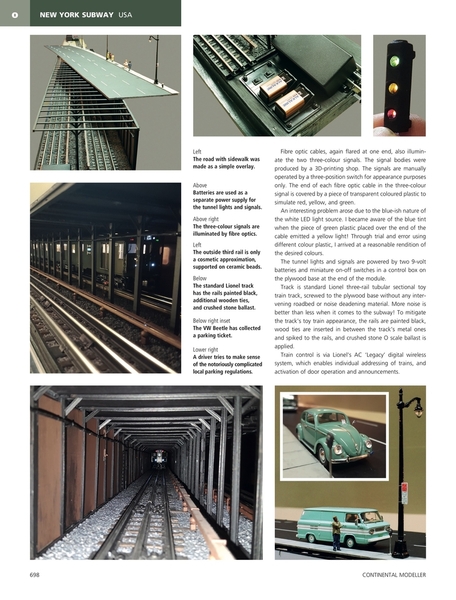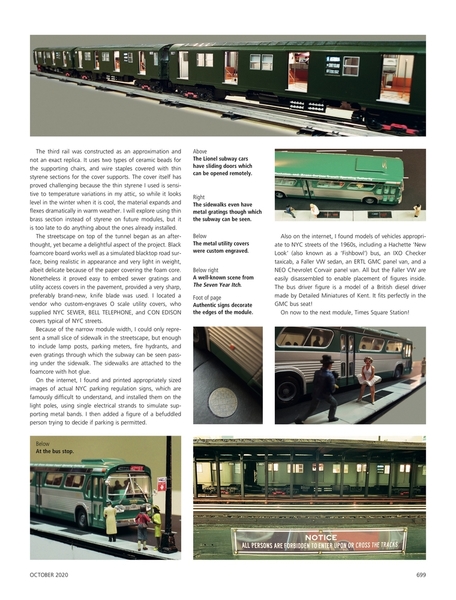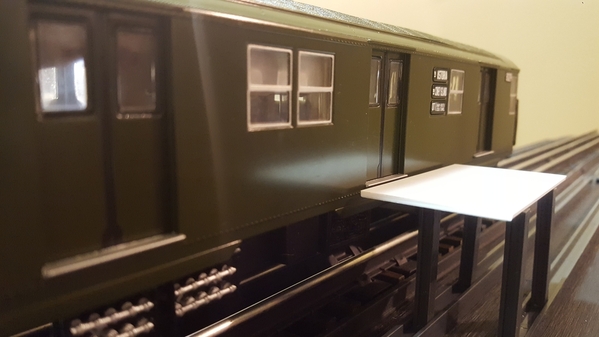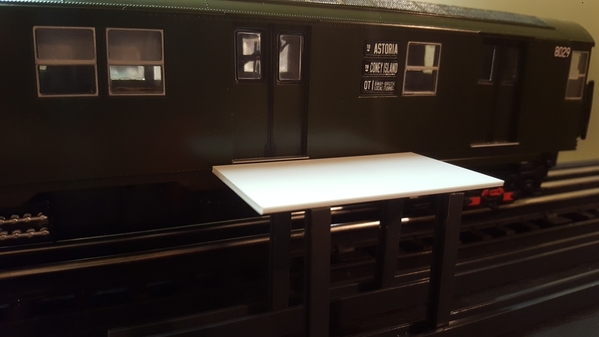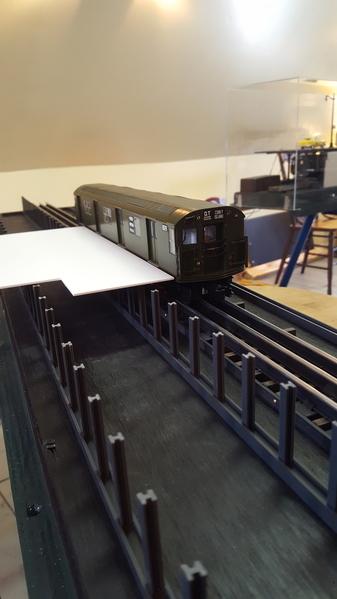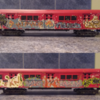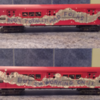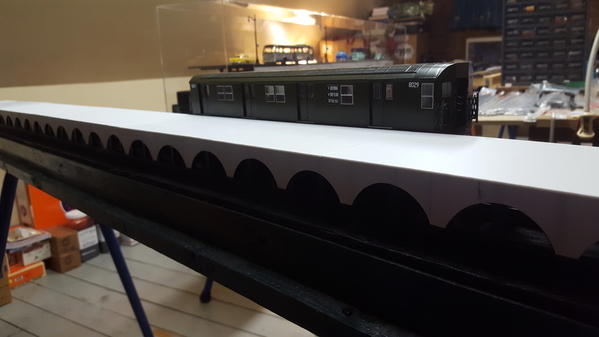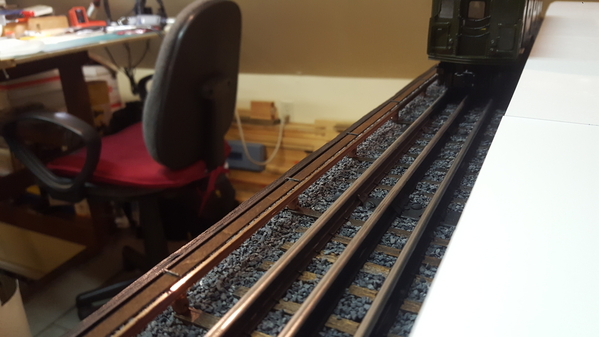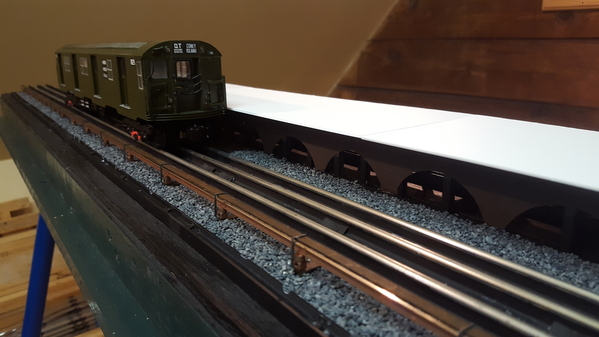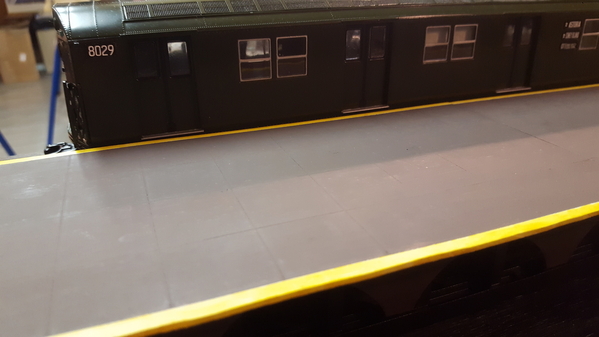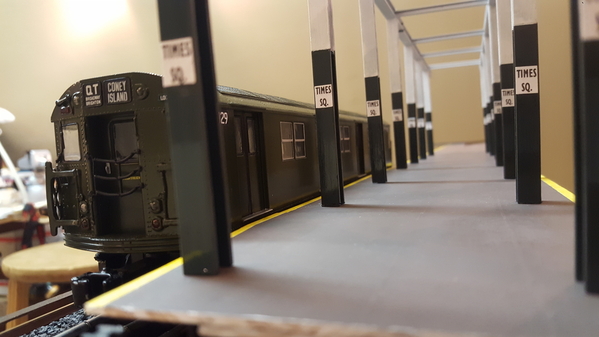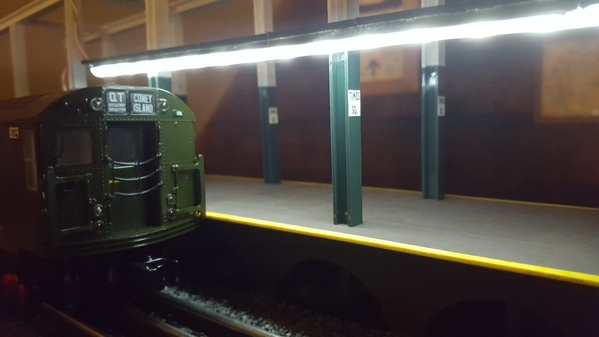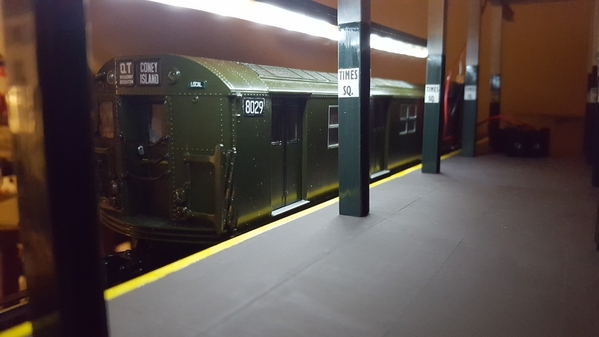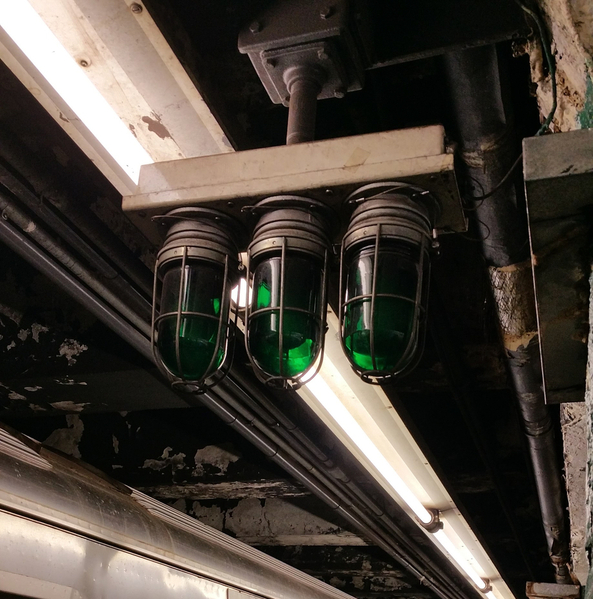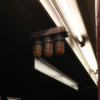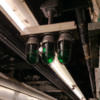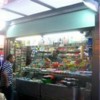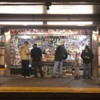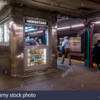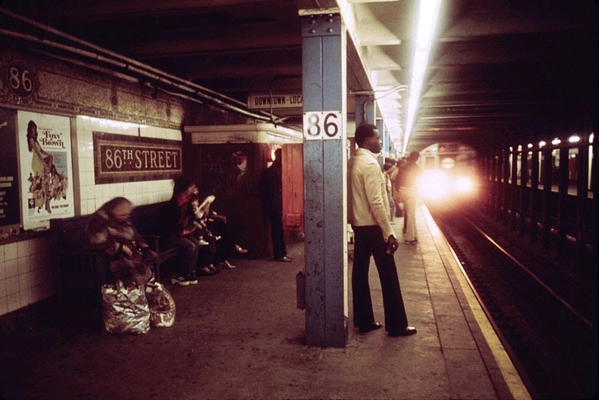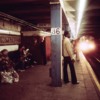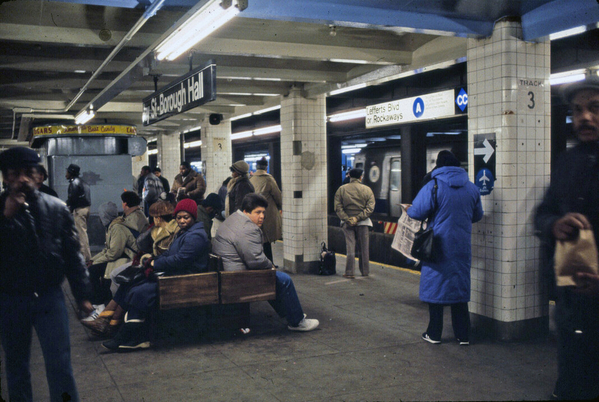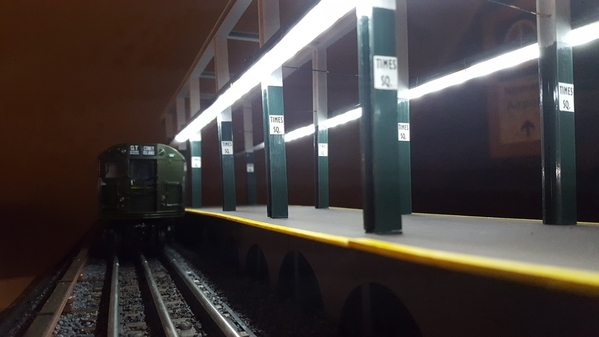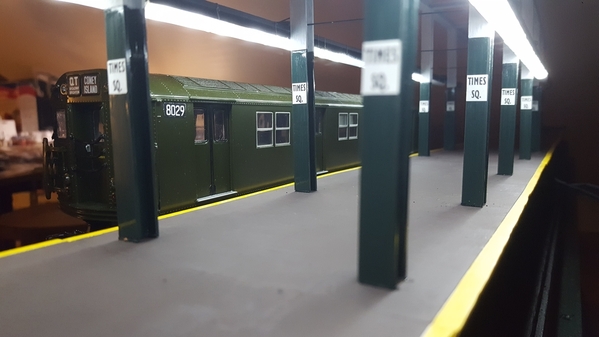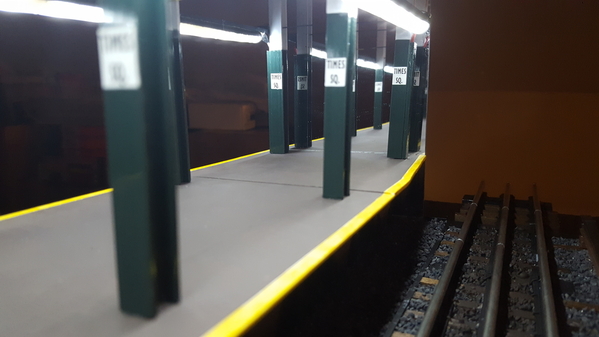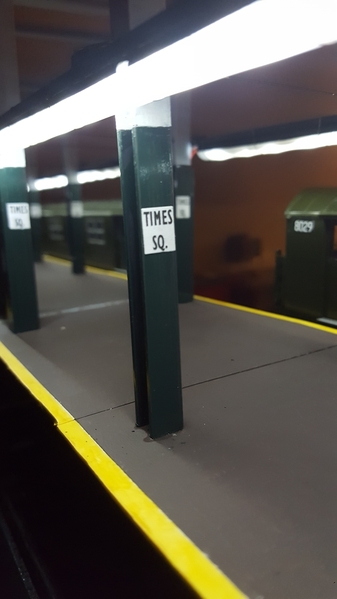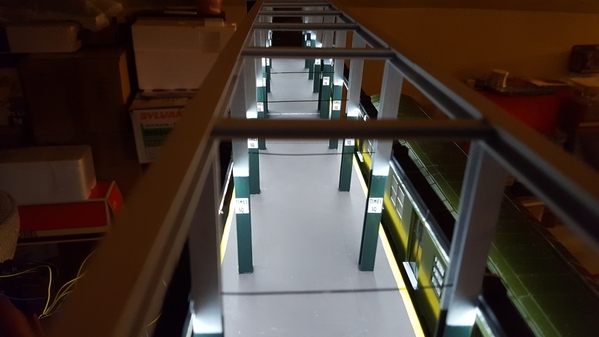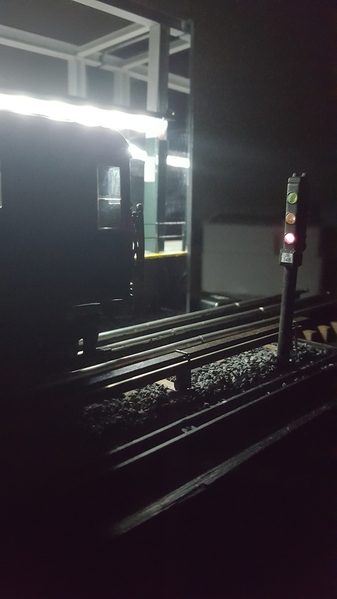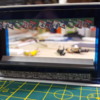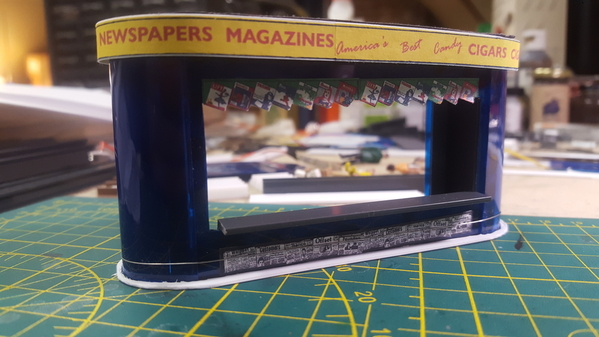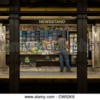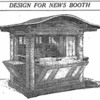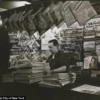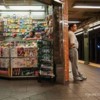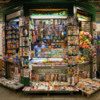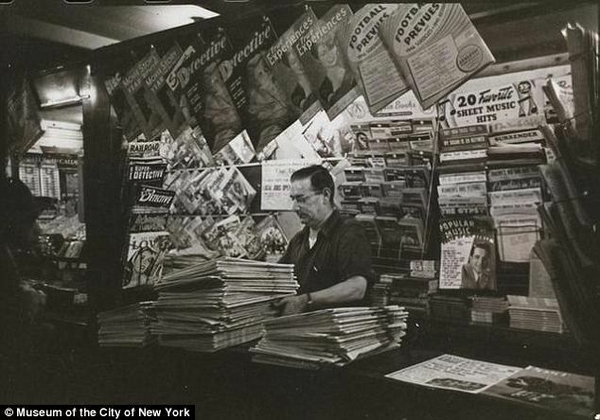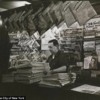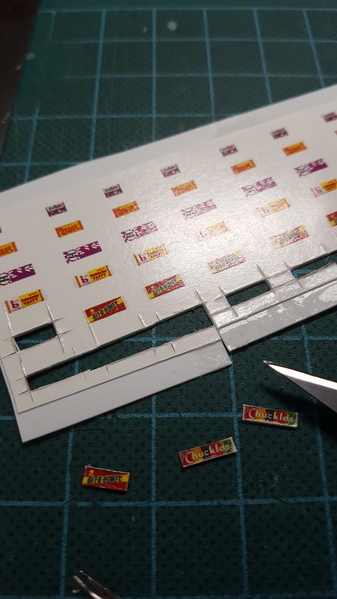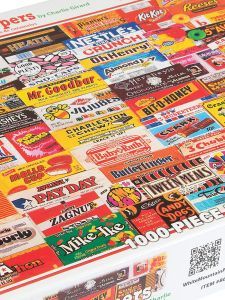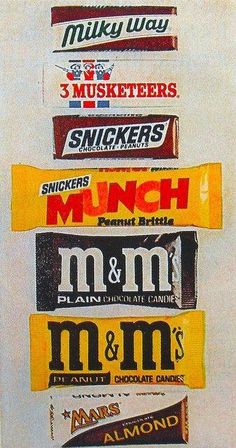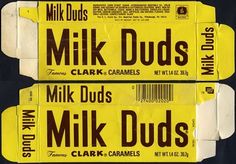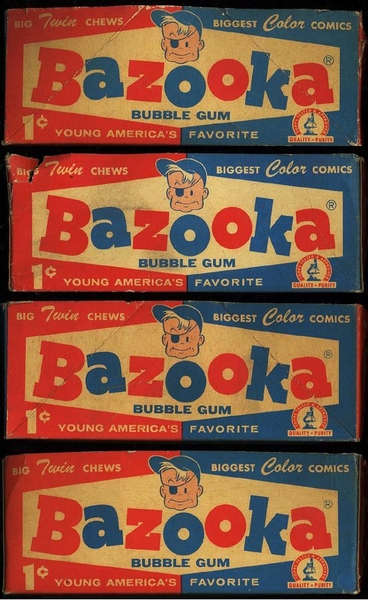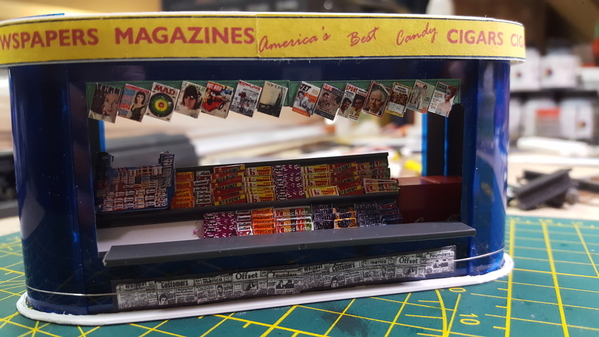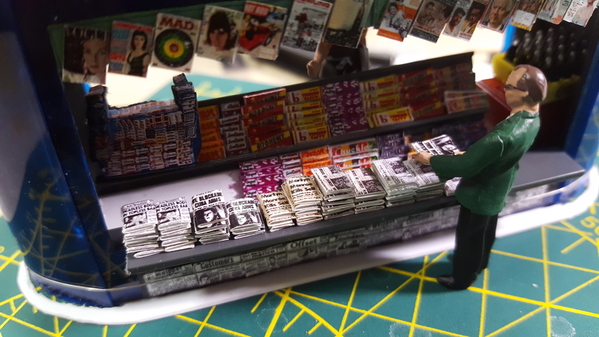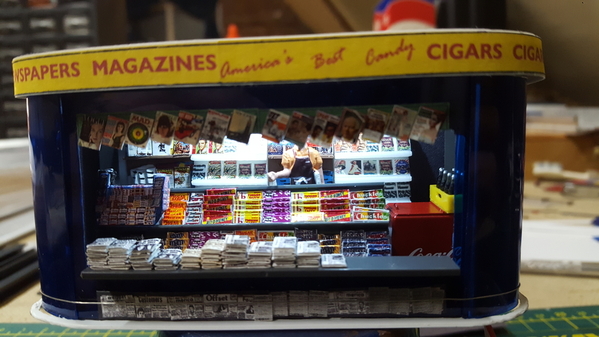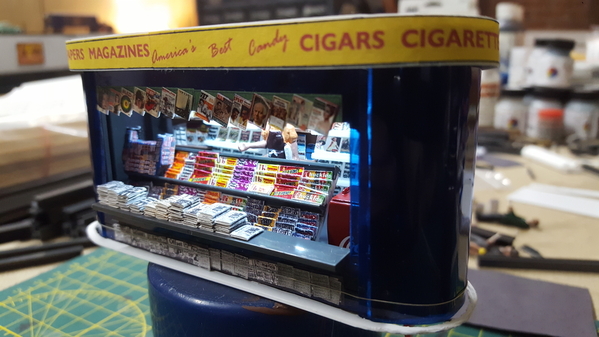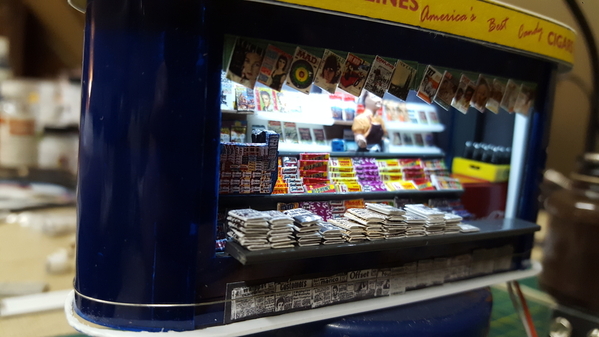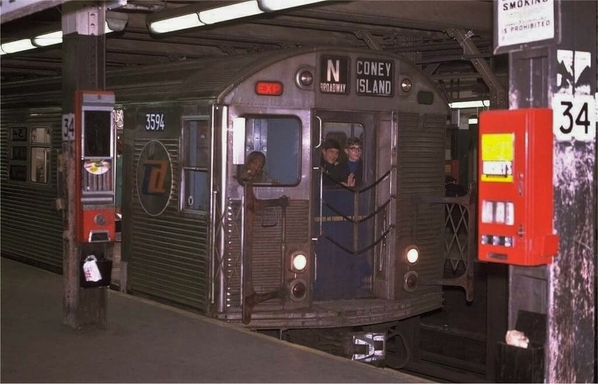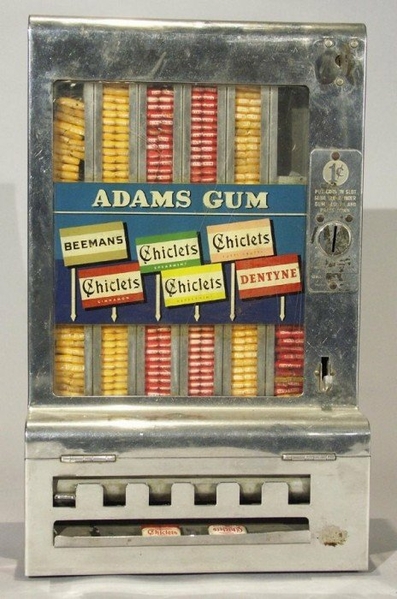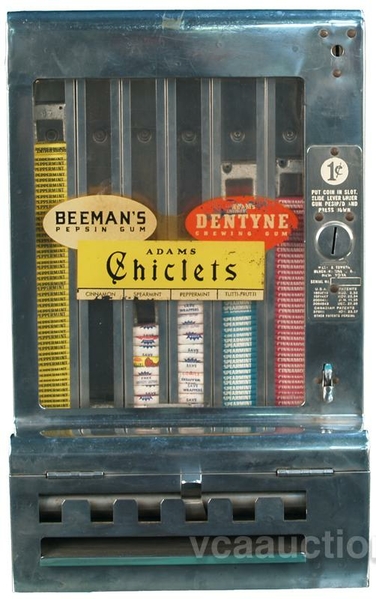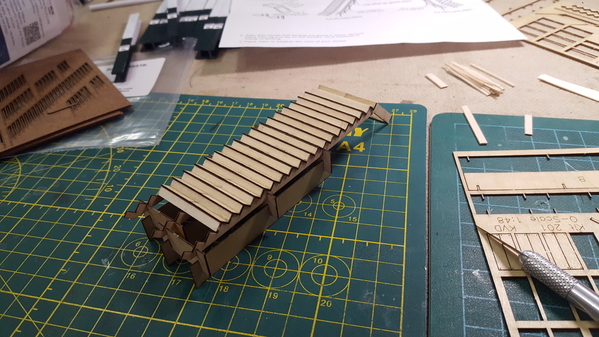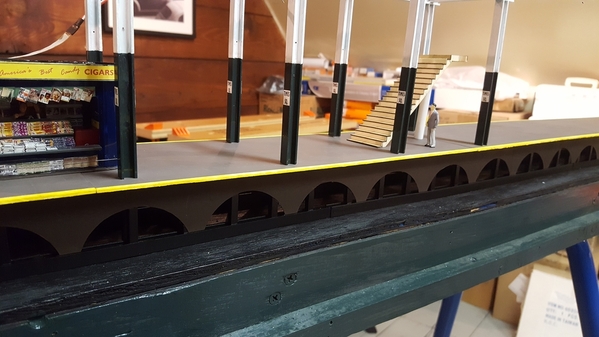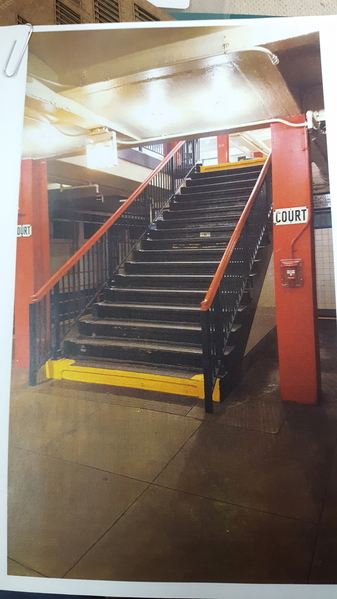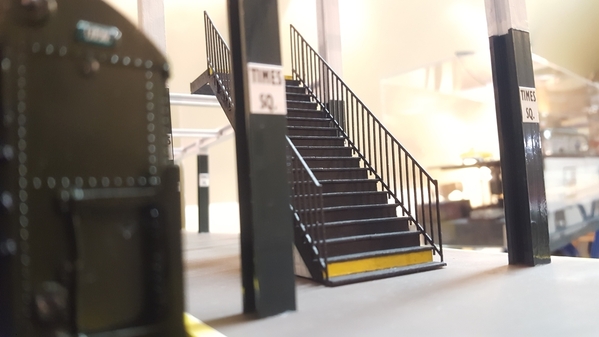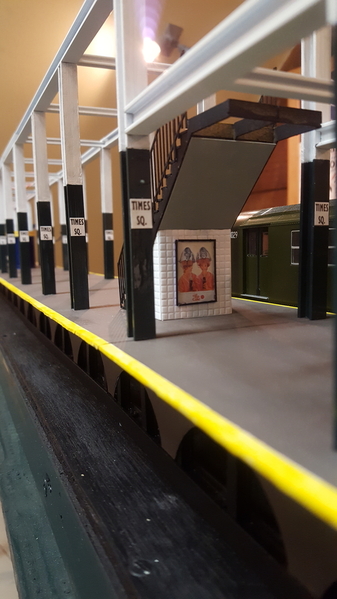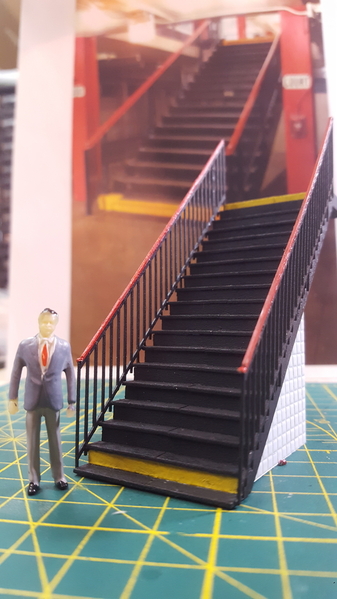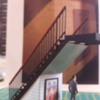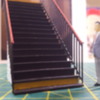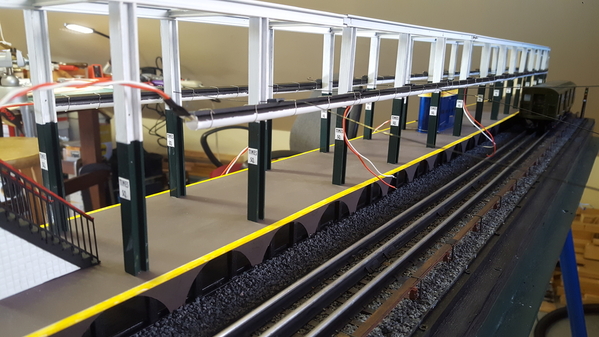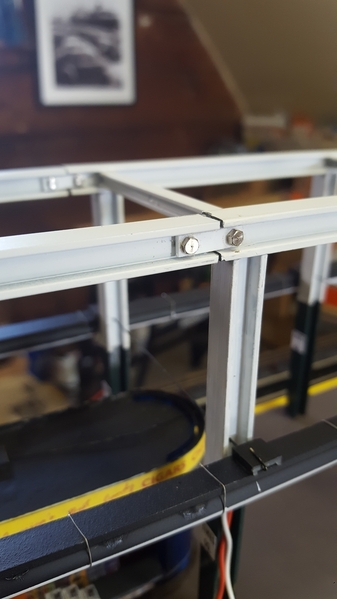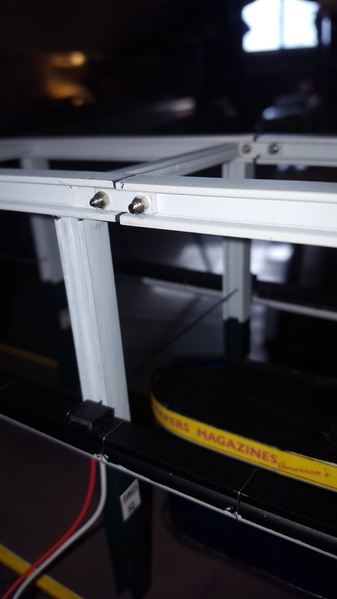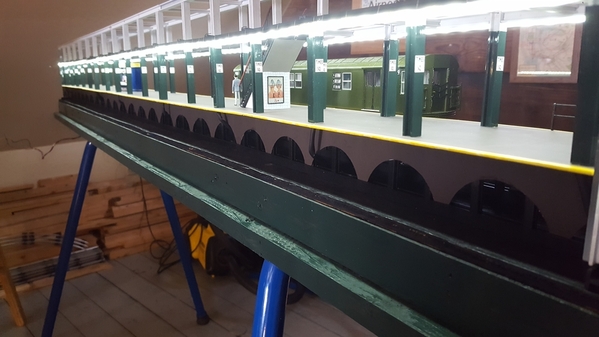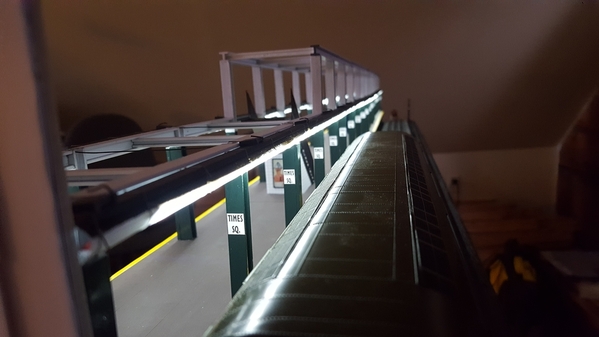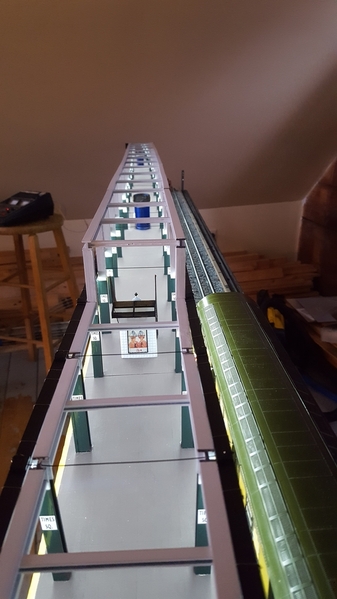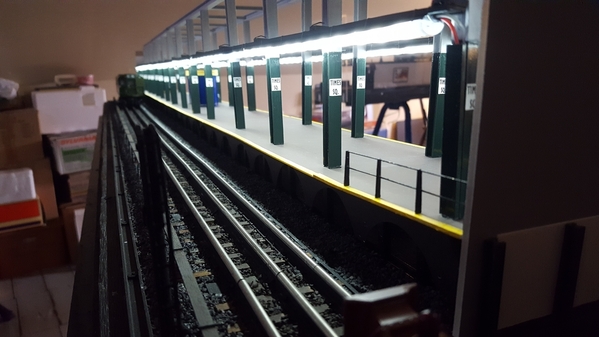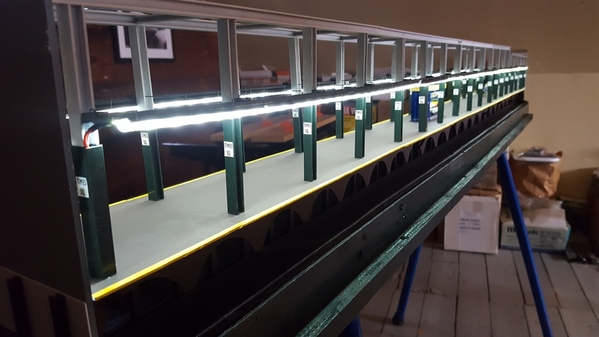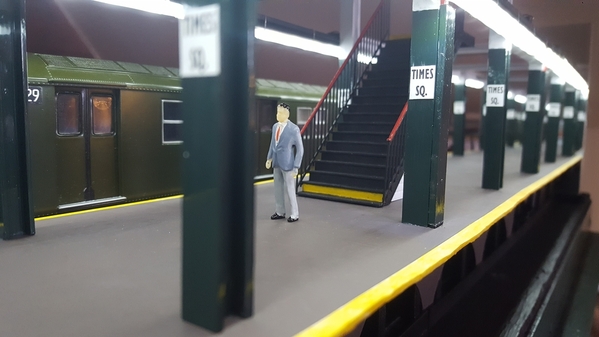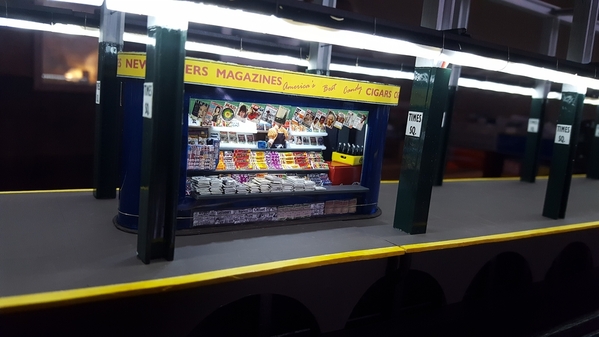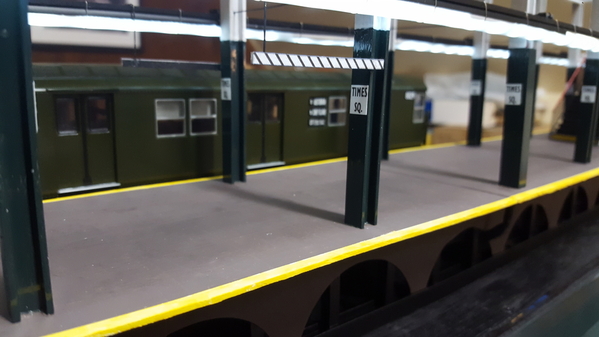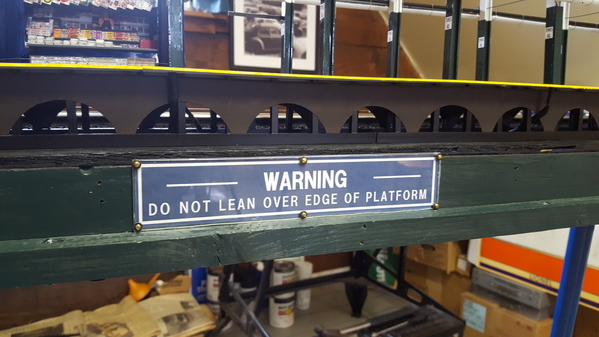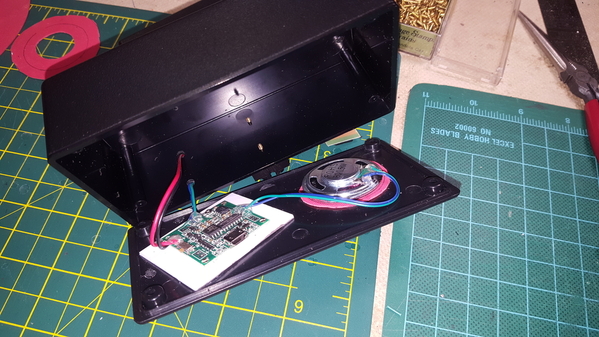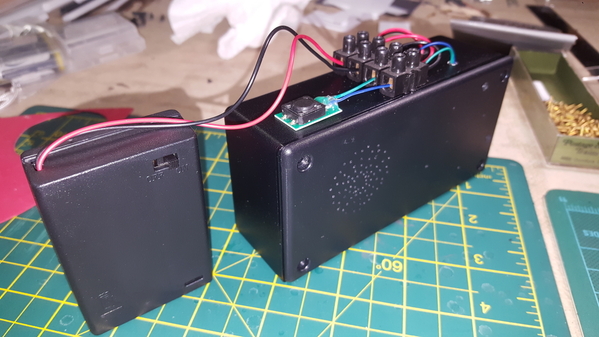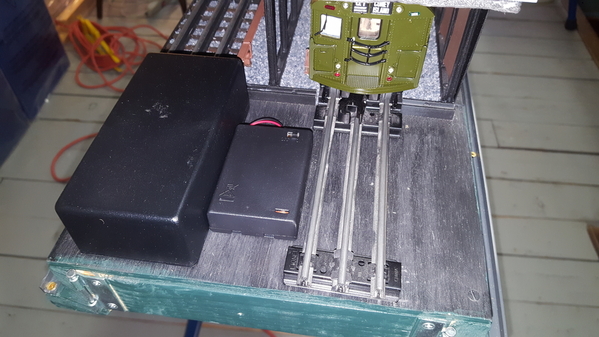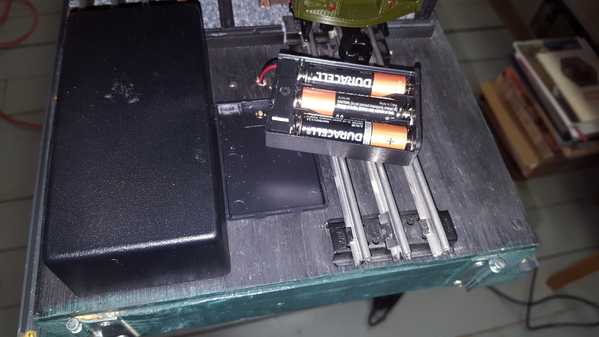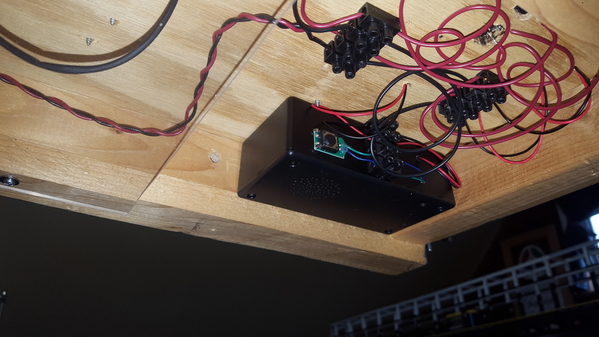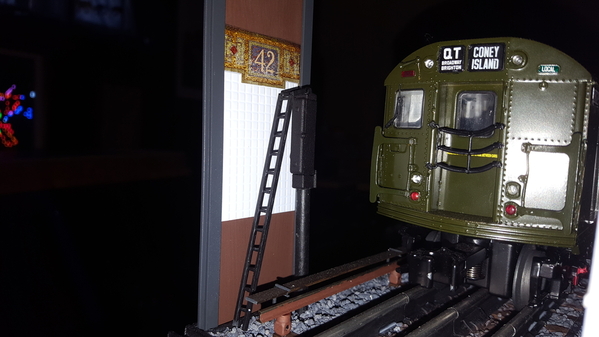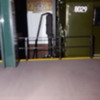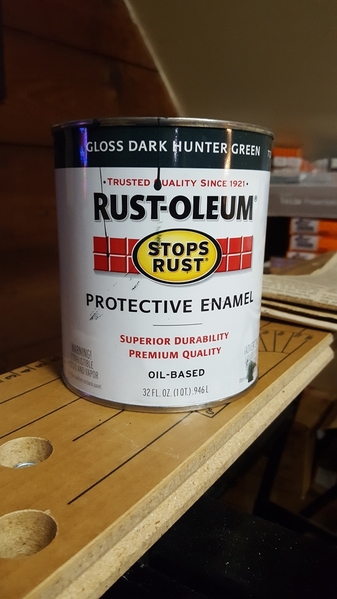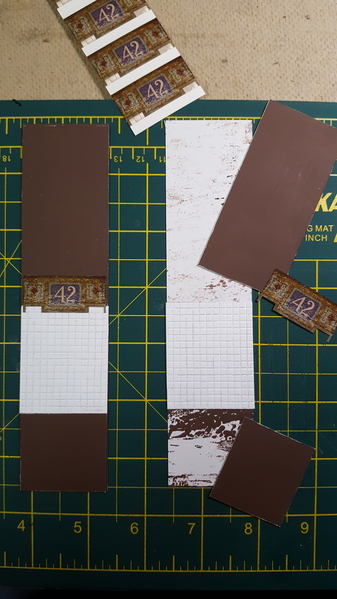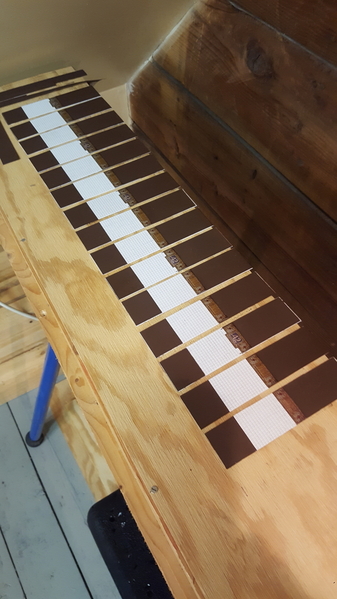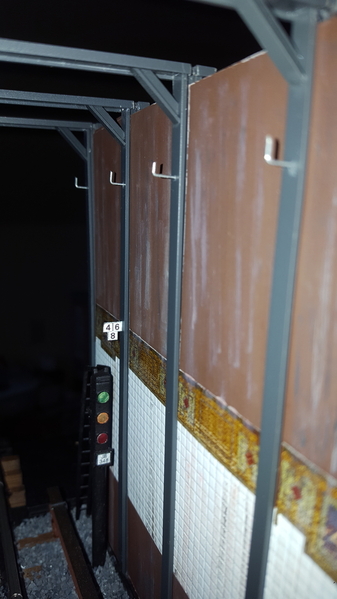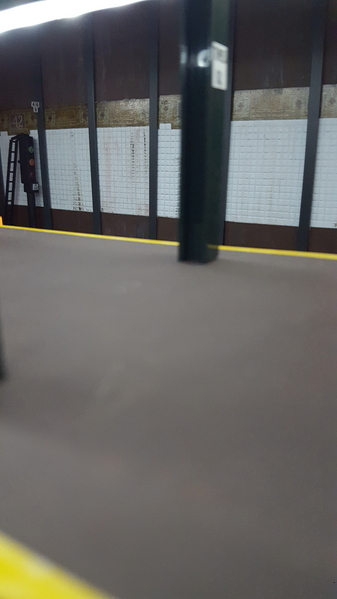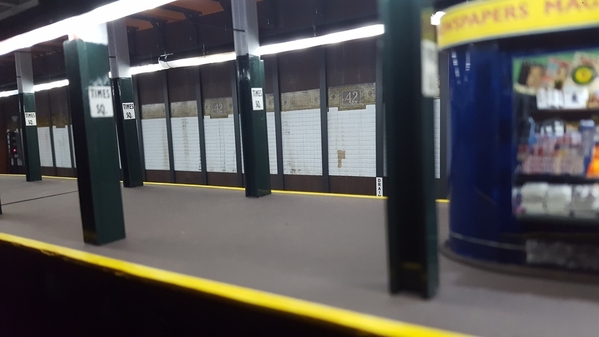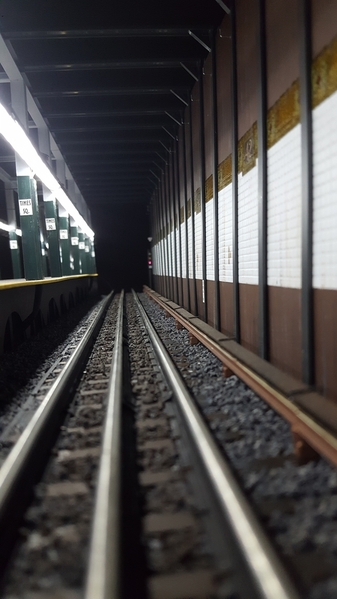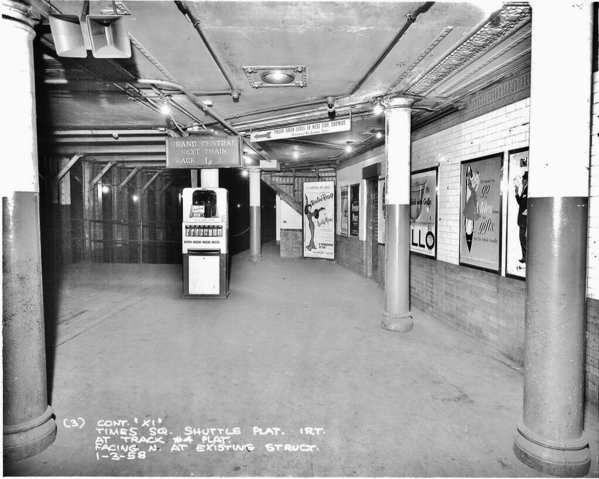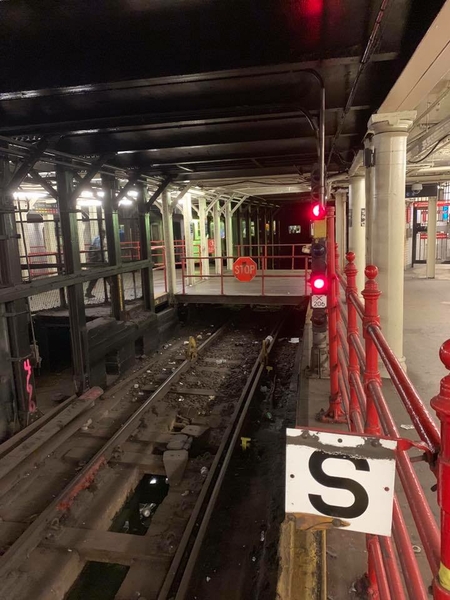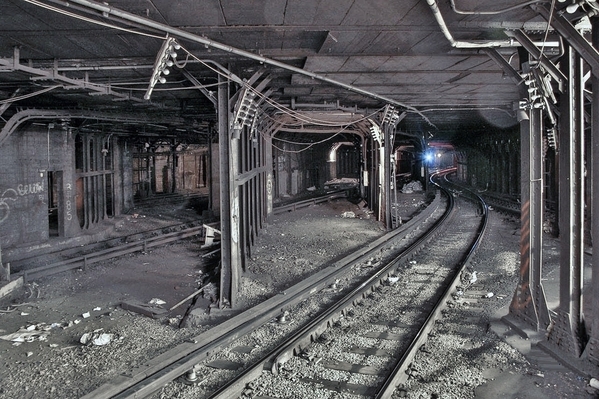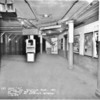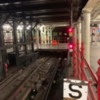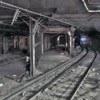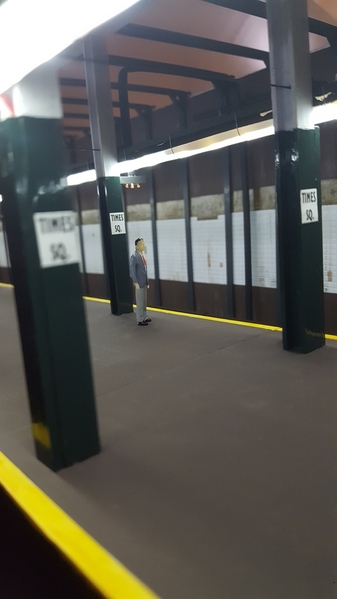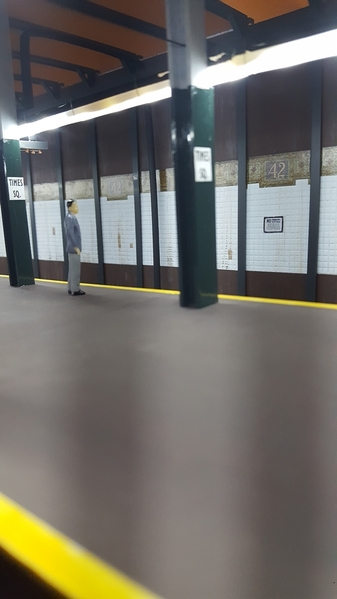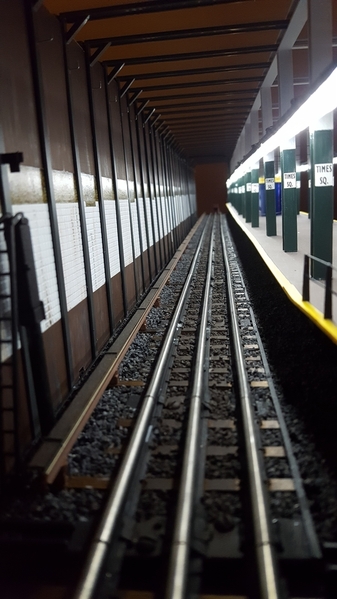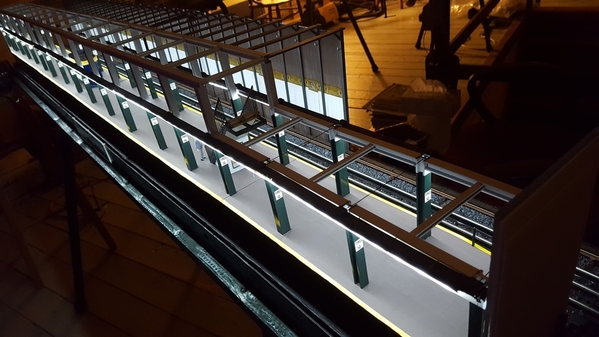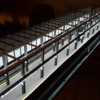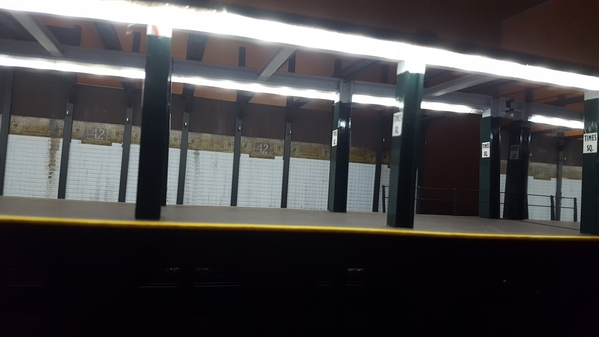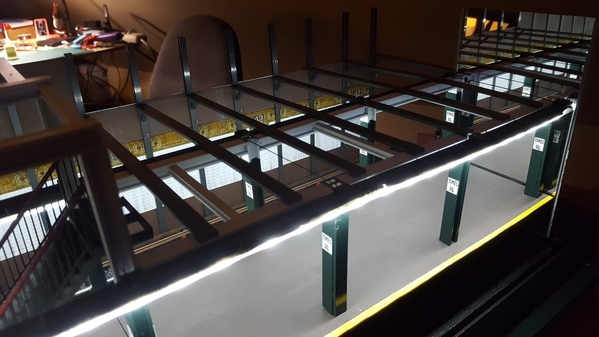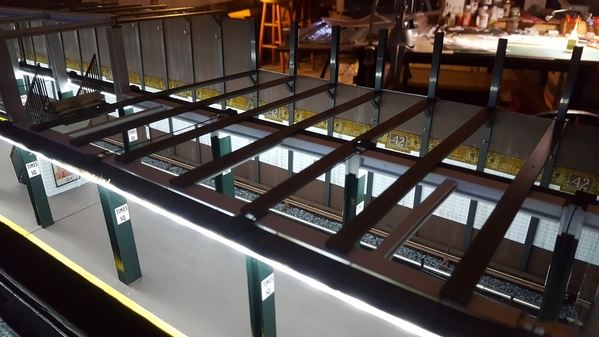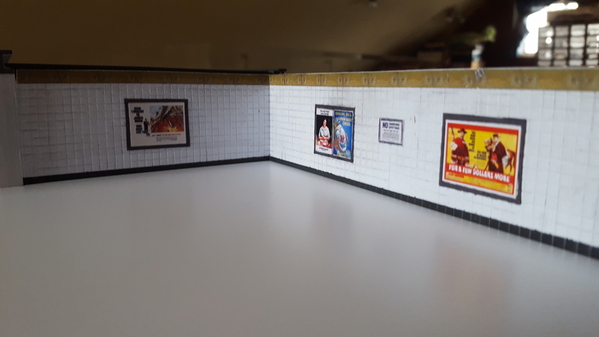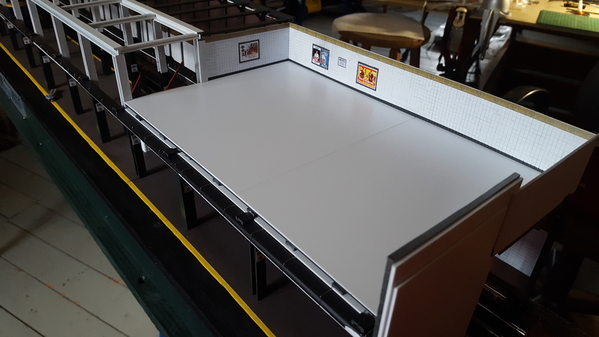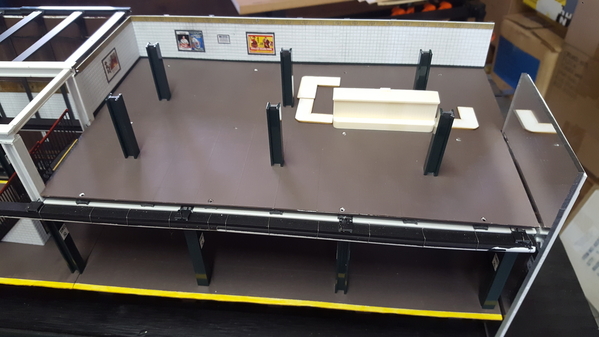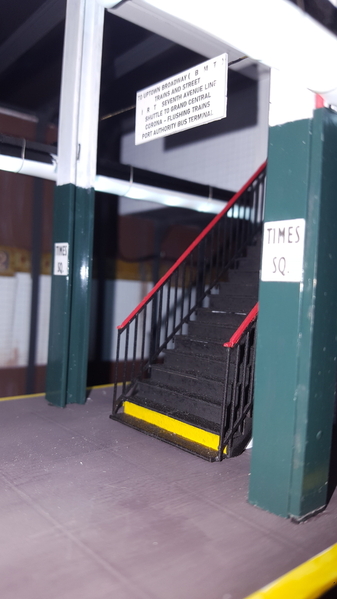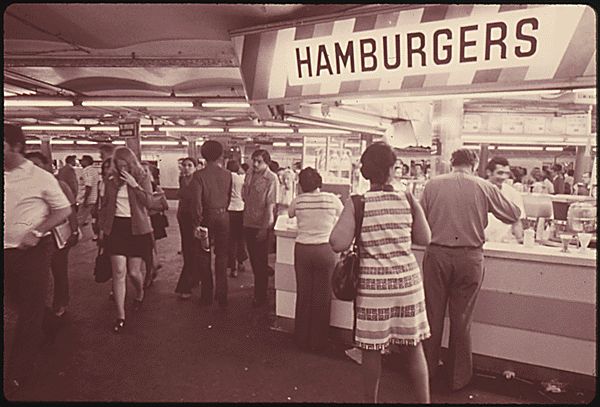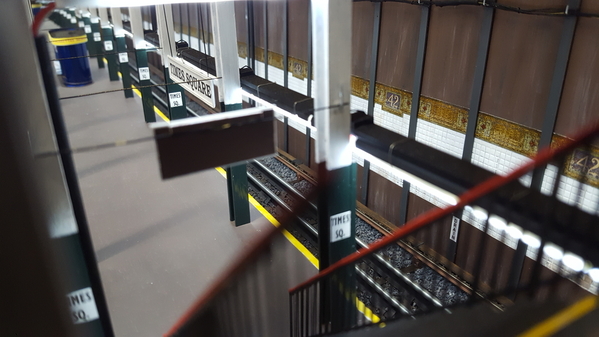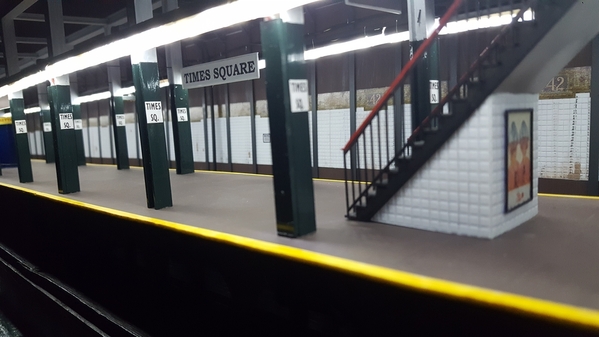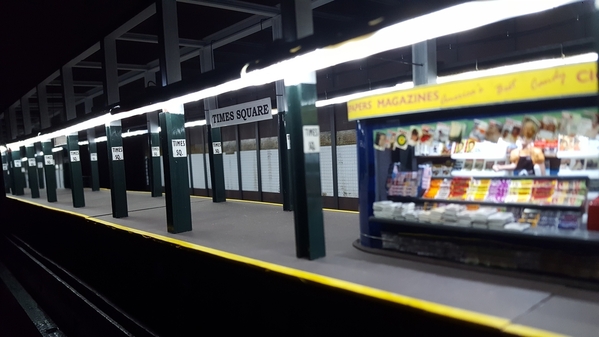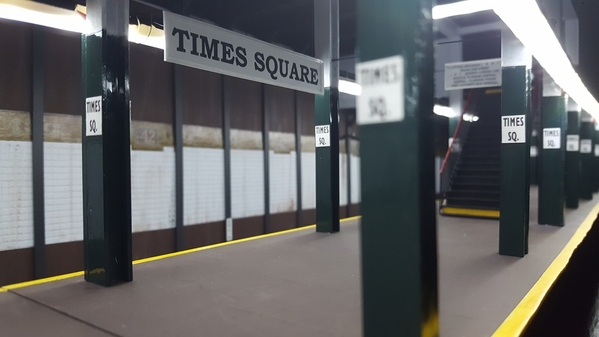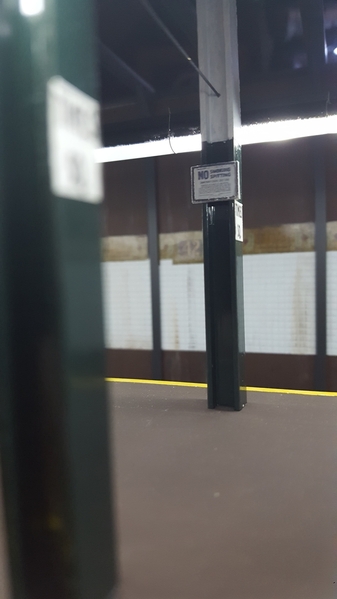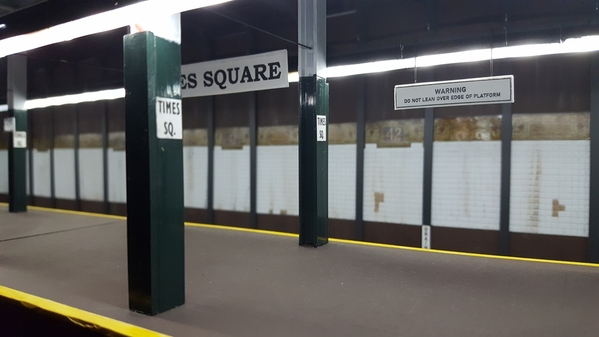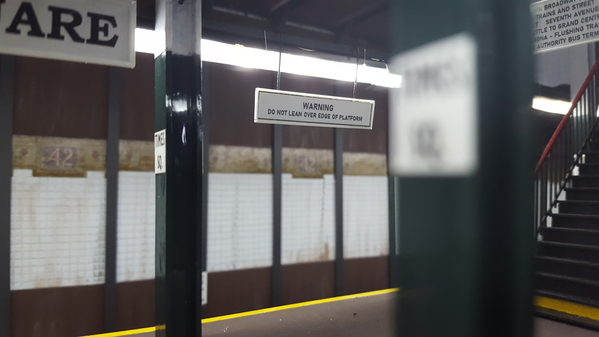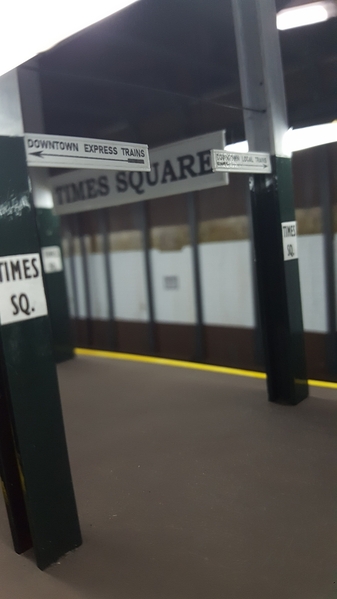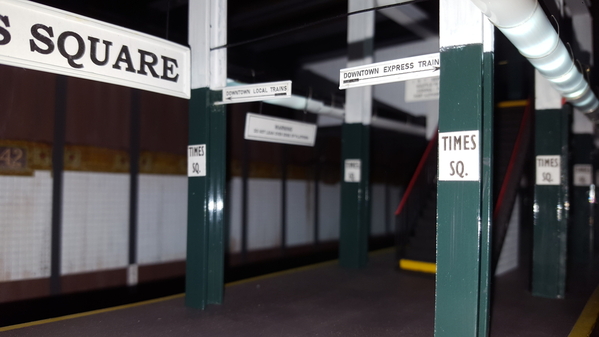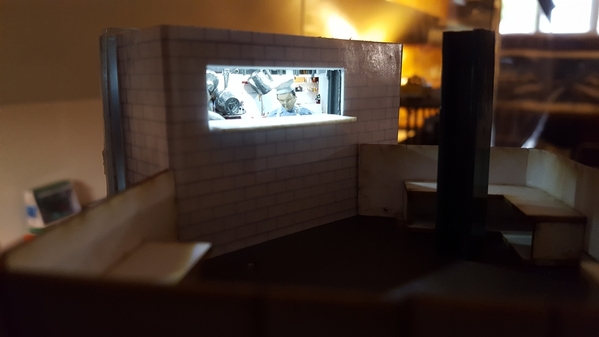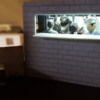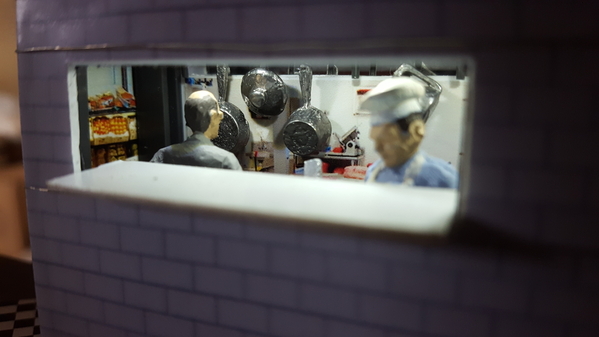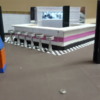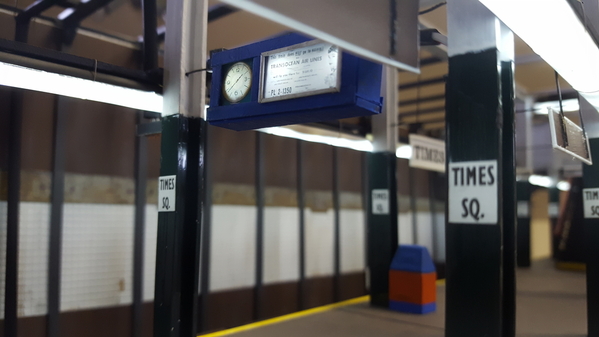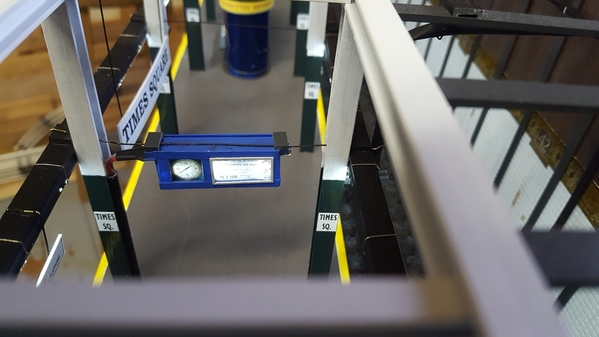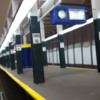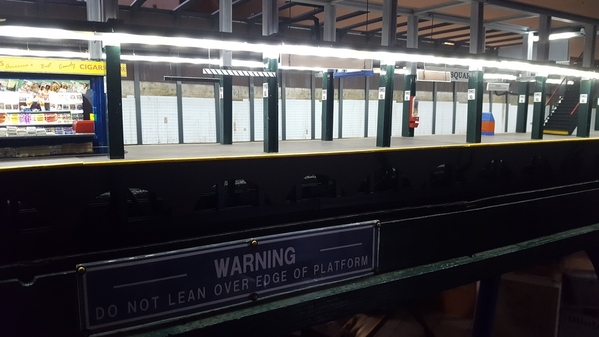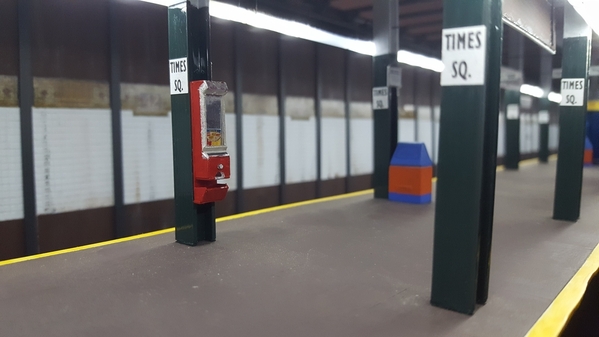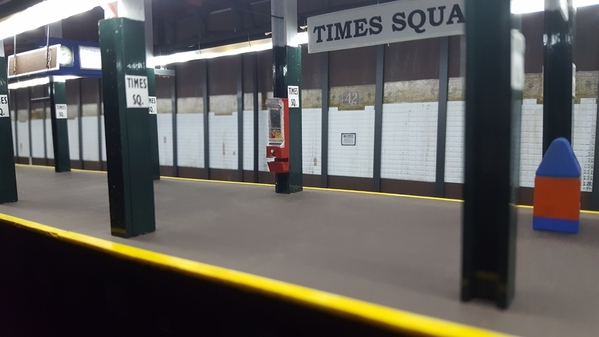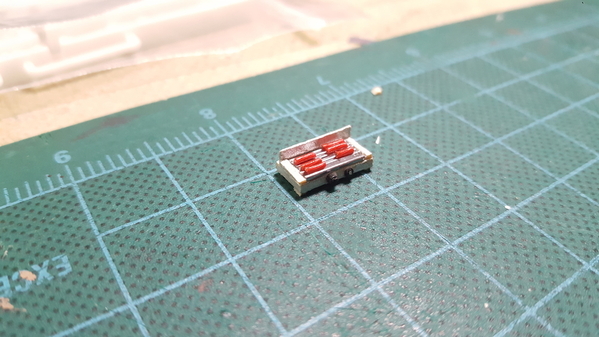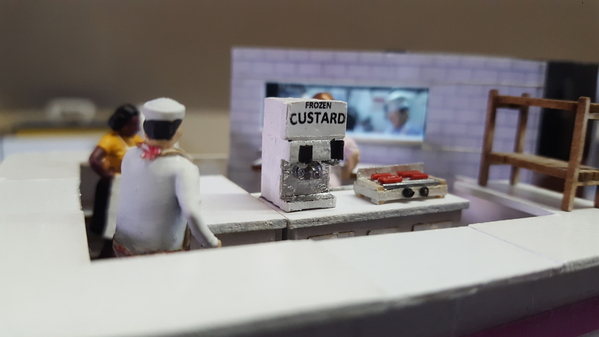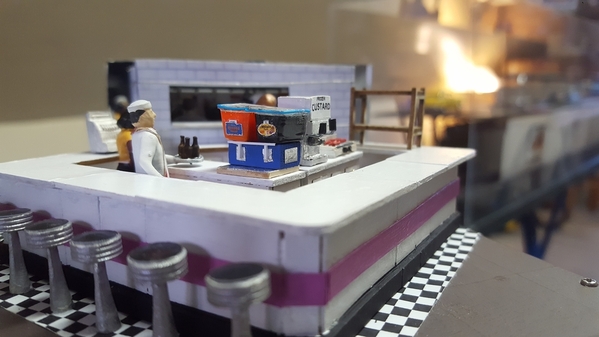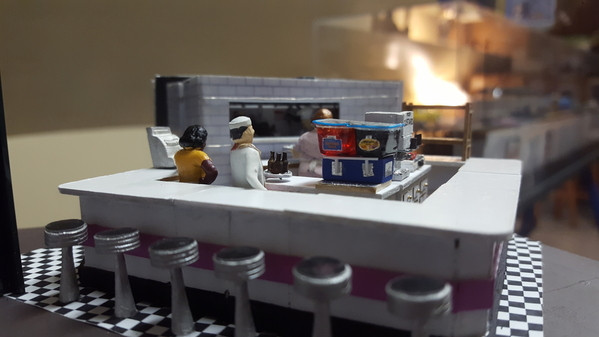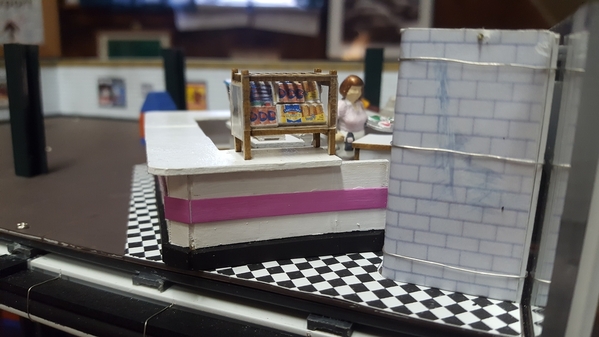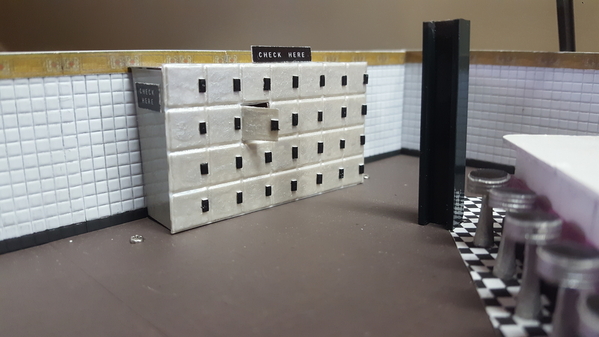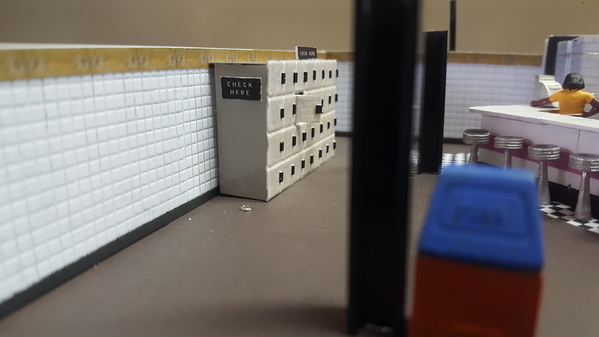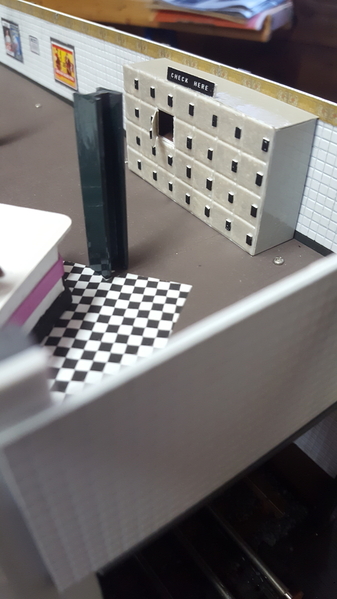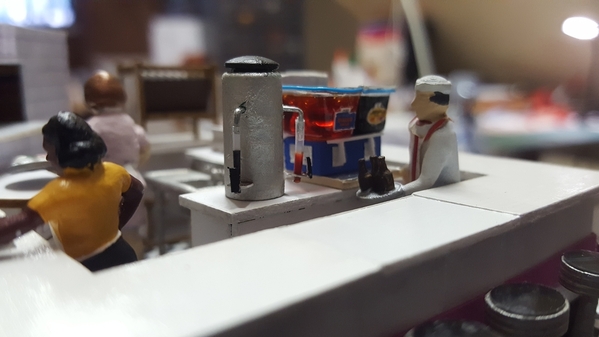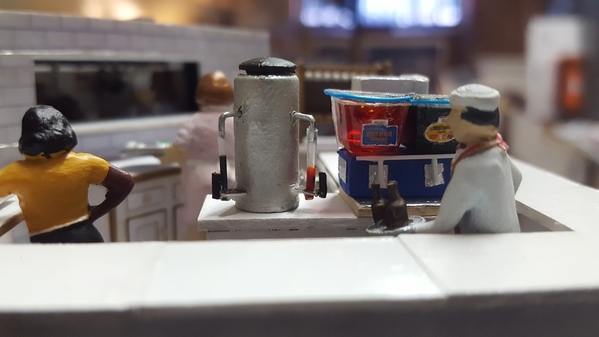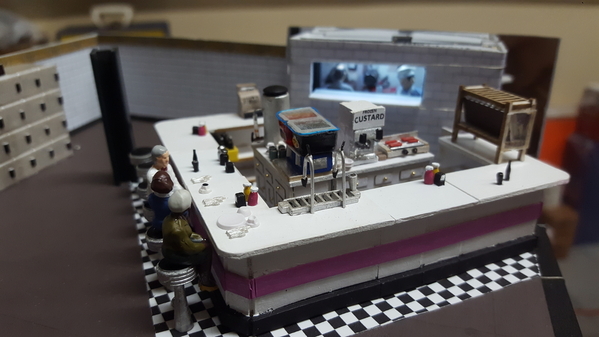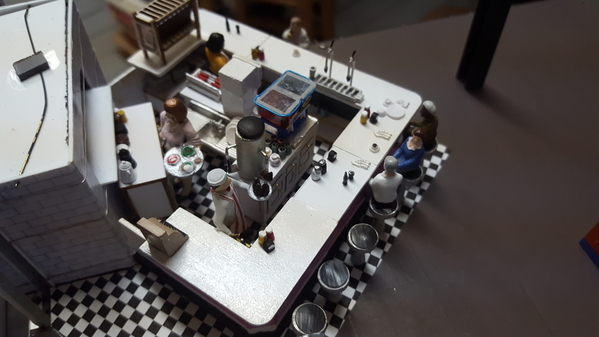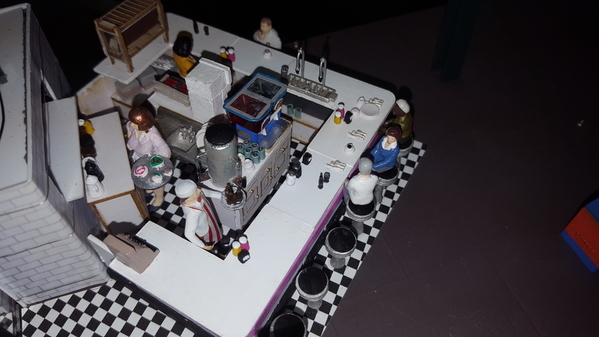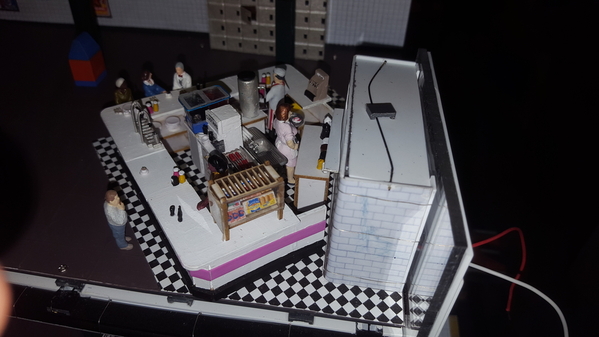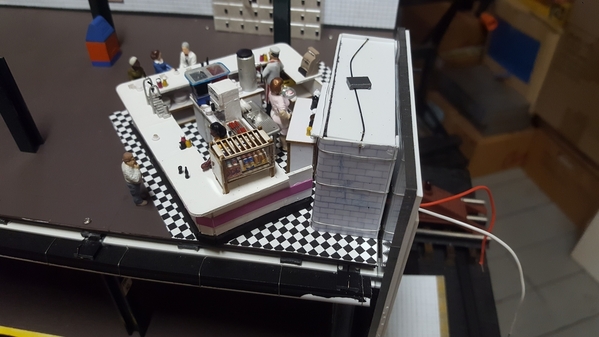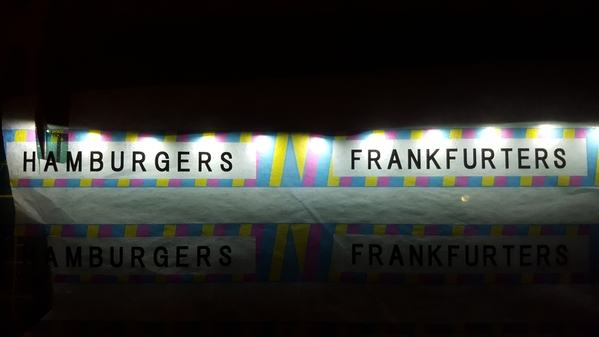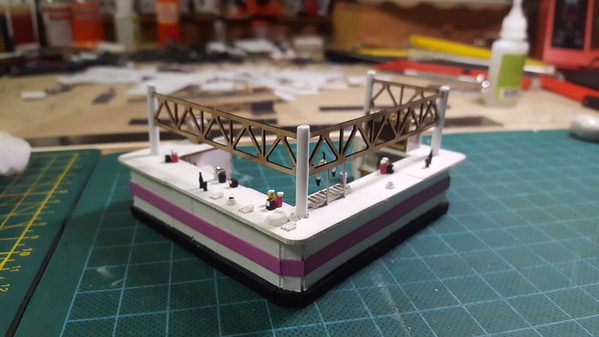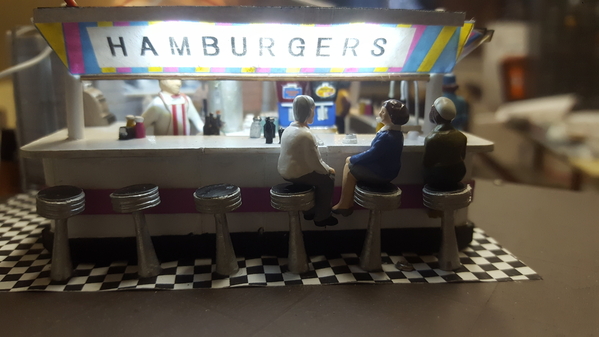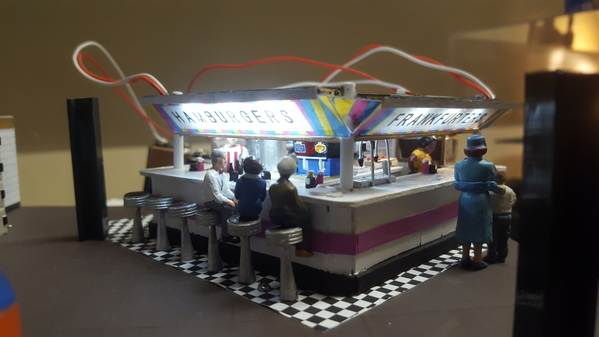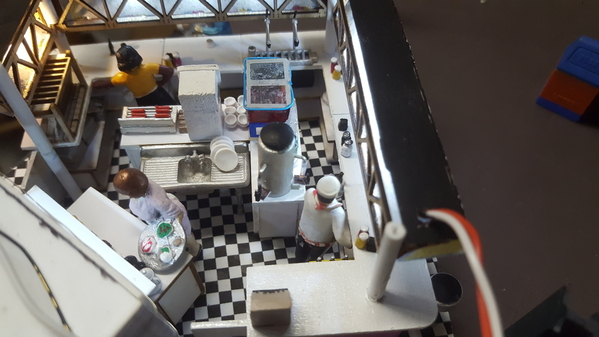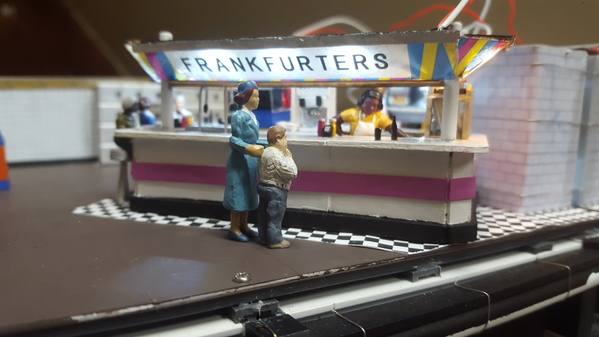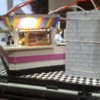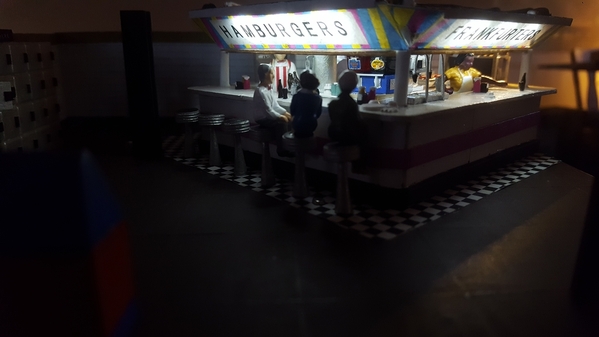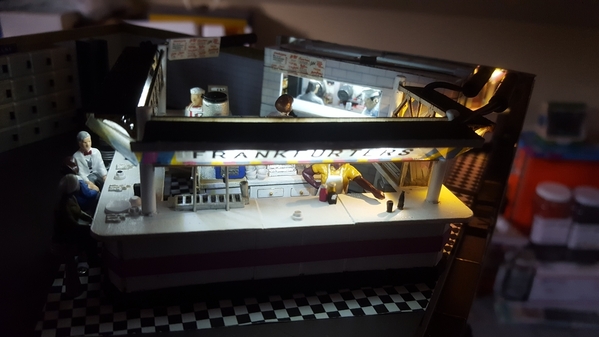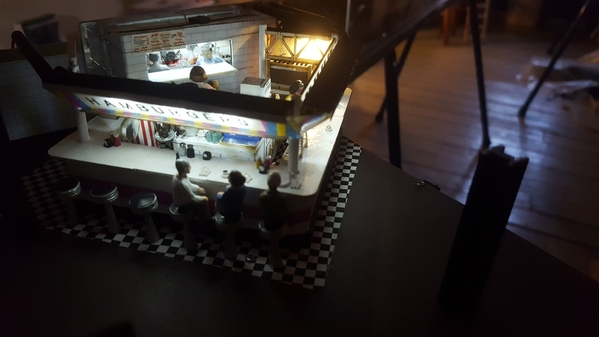All the years I've been in this hobby, I've always thought how nice it would be to share my efforts in a modelling publication, but I never had anything worth sharing. It finally happened. The first module of my subway layout, in the October 2020 issue of Continental Modeller magazine. Hope you like it. The rest of this thread will cover the construction of the second module, Times Square Station.
Replies sorted oldest to newest
Nice article and Excellent work, west side! Thanks for sharing and I’m looking forward to seeing more posts on your module progress.
Great article The removeable roadway is a great idea
An amazing piece to say the least, modular system is museum quality.
Attachments
Just received my hard copy of CM the other day and read your article Joe, great work! Having grown up in NYC area and being a former commuter, you got it right!
Miketg
@West Side Joe posted:All the years I've been in this hobby, I've always thought how nice it would be to share my efforts in a modelling publication, but I never had anything worth sharing. It finally happened. My subway layout in the October 2020 issue of Continental Modeller magazine. Hope you like it.
Lov your work Joe subway cars rock 👍
Attachments
Great work!
Peter
Attachments
Attachments
Good Stuff !
Attachments
Attachments
Stations where subway trains are held by dispatchers to meet other trains or let them pass, have departure signals consisting of three orange bulbs, placed along the platform so the conductors can see them from their positions. When the dispatcher wants the train to leave, the lights are turned on, and the conductor proceeds to close the doors. This is my rendition of a departure signal for my 42nd St. station module.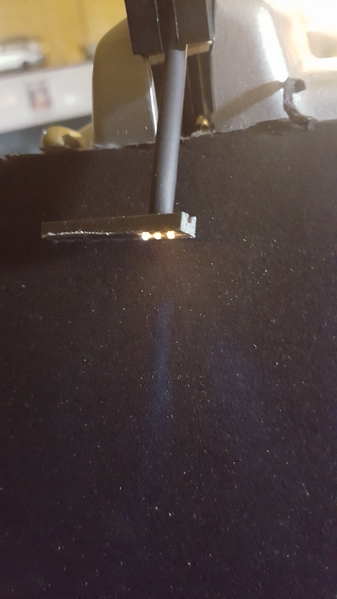
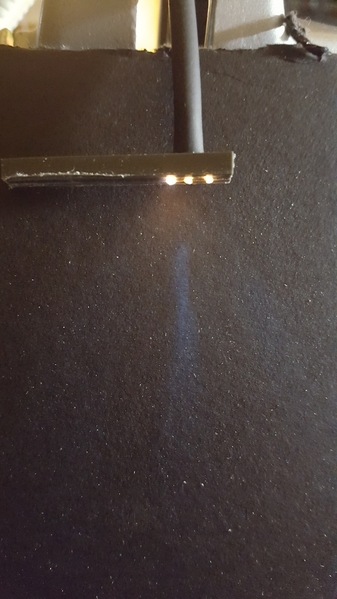
Attachments
For 42nd street, which is where your model is re-creating--you would have 'holding lights' which operate the opposite of the way described--turned on to hold a train in the station, and are turned off when the train is allowed to proceed.
At terminals, yes, I believe such lights are turned on (usually accompanied by a gong) to signal crews of clearance to depart. For both installations, I've never seen them recessed into any sort of enclosure--most of each bulb is visible (the individual bulbs may be shielded by plastic domes, such that standard sized LED's would make for a good replica either way.
---PCJ
Really nice work West Side Joe - I feel like I've been there!
PCJ, thanks for the clarification. It's been a while since I've ridden the subway due to this pesky virus, so I couldn't remember which way the lights worked. Re: the bulbs themselves, when I do the final installation I will maneuver the flared ends of the fiber optic lines so that they protrude similar to the actual bulbs. I went with fiber optic because I have extra fiber and illuminators, and the fiber is a bit oversized but I'm happy with it.
I love it!
What are you using for lights?
All the mini LED sets I see are too long (35 ft, etc) . The short sets are battery operated and too weak for my taste.
I got them from Murton Scale Miniatures on Ebay. Here is a link to their Ebay store. http://www.ebaystores.co.uk/Murton-Scale-Miniatures
Thanks, Joe!
I made a couple of trips via subway last week and thought of this post, so I took a couple of pictures:
Holding lights (149th St/3rd Ave, 2/5 line)
Starter lights (205 st terminal, D line)
Hope these are helpful,
---PCJ
Attachments
Thanks. I'm adding those photos to my set of references for this project. ☺
Seeing as this group rose to the occasion when I was looking for the colors of the subway hamburger stand awning for my Times Square subway module, here is another request: I am looking for photos of the platform newsstands in the subway in the 1960's. These were on the island platforms, not the ones recessed into the station walls. I recall they were rather futuristic looking, with curved ends, and painted a medium blue. If I can't find a pic, I will work from memory, but a photo would be great.
Thanks. These are contemporary examples. My module is set in the 60's, before the days of graffiti-proof brushed stainless steel surfaces. These pics are useful to establish overall dimensions. But I have searched high and low for 1960's - vintage pics of the particular newsstands I recall, without finding one.
You are welcome. Like you I am building my layout, finally, subway and an elevated on top of it. The era I am modeling are the late 50’s to 1970 before the graffiti era.
I have been searching for pictures during those years and have had some mild success. I came across pictures on Pinterest, Forgotten New York and other sites.
Attachments
BTW, there is a mirror at the end of the platform.
Lol! “Isn't obsession wonderful? 🤗” Yes, but what a wonderful distraction from the mundane and disturbing reality around us! Thank gosh we have our little projects to obsess over during these crazy COVID times. Absolutely great work, west side.
Although this format of 6 foot long by 10 inch wide modules has a lot of limitations regarding space available for trains and scenery, one very nice benefit, especially for an old guy with back problems, is how easy it is to gain access to the underside by just tipping the module up onto its end. 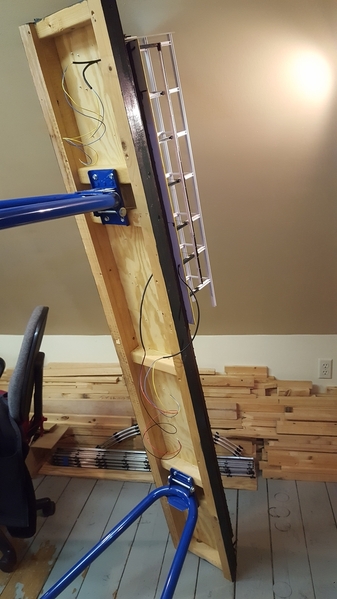
Attachments
Attachments
Attachments
Looking good !!! I am still looking for pictures. We are in the same era.
Joe, love your work! Top shelf. That newsstand is looking good!
I had a thought. You are adding such authentic details, including the outside third rail. How hard would it be to add a third rail pick up to the cars, bypass the center rollers and eliminate the center rail? Of course I realize this would mean redoing the track work, so I guess that ship has sailed. But I wonder if anyone has tried this with the MTH subway cars.
I'm sure there are threads on here on doing exactly that, but you'd have to search. Also, nycmodeltransit.org has a page about modeling third rail:
Joe
I came across some more pictures.
Will
There are modelers who have converted the MTH Subway cars to two rail. Click on the link in my signature below. Also, check out https://groups.io/g/NYC-Transit-Modelers-Group.
and on Facebook O Scale New York.
Attachments
Thank you! ☺
Steve, I especially like the Museum of the City of NY black and white picture. If you zoom in, you can see a display of sheet music for popular tunes (surely an endangered species already as fewer and fewer people were learning to play musical instruments by then), and to the upper left, nearly hidden by copies of Detective and True Experiences, there is a copy of Railroad Magazine. A real time capsule, this pic. Thanks.
Attachments
BTW The newer style starting and holding lights look very similar to the ones you modeled You will see them in any new station or rebuilt station
Joe
You are welcome. What drew my eye to it was the stack of newspapers. Time, Daily News, Post.
Ill have to zoom in to catch the magazines !
Someone else has found that the newsstand photo was taken by Stanley Kubrick (yes, THAT Stanley) in 1946 when he worked as a staff photographer for Look Magazine.
Attachments
JOE JUST CURIOUS WHO MADE THAT SUBWAY CAR. SPENT MANY A DAY GROWING UP IN THE CITY RIDING THE SYSTEM MAINLY THE MYRTLE AVE EL GATE CARS 1950'S. REALLY LOOKS GREAT. KEEP UP THE GREAT WORK. LIONEL 13
The subway car was made by Lionel. It is part of their 4-car R-27 set.
Attachments
IMPRESSIVE WORK! :-)
Just curious, why if you put in outside third rail, that you still had center rail. Why not use 2 rail track with the outside 3rd?
Prrjim, the third rail is cosmetic only, not functional. I'm not handy or ambitious enough to convert the Lionel R-27 set to outside third rail operation. ☺
Attachments
Fantastic Joe.
Unbelievable attention to detail!
The Mad magazine brings me back to the 1960s.
@Glen S posted:Unbelievable attention to detail!
The Mad magazine brings me back to the 1960s.
All the magazines and newspapers are images of actual 1962 issue covers and front pages.
Attachments
Fabulous!
As a current Train Operator in the NY system I commend your attention to detail, very nice. I too love to dabble in subway modeling (as it’s what I stare at all day, lol). Only thing I would add is a “catwalk” along the benchwall in the tunnel. Any questions do not hesitate to ask.
@Maverick0394 posted:Only thing I would add is a “catwalk” along the benchwall in the tunnel.
Totally agree. When I began planning the tunnel module, I used the original IRT as a model, which did not have a catwalk. I did not realize that since the subway I am running is a BMT model, the tunnels it ran through would have had the catwalk, unlike the IRT. You are the first person to mention that, and the omission of the catwalk has been bothering me for quite a while. Maybe after I finish the other modules, I'll go back and install the catwalk. I left more than enough room in the tunnel to add one. Thank you for your perceptive comment.
Joe, do you post on a FB page called "Only the Finest in O-scale Railroading"? Because there is an identical newsstand there.
Yes, I do. You're the first person that has made the connection. I like posting in both places. Different reactions, different perspectives. ☺
I found your page on Facebook and sent a join request.![]()
@West Side Joe posted:Yes, I do. You're the first person that has made the connection. I like posting in both places. Different reactions, different perspectives. ☺
Good. i just wanted to make sure no one else was posting your beautiful modeling as their own. It was funny watching the same idea evolve in two places before I realized it was the same model.
Looking for some suggestions regarding how to proceed now that that the newsstand is finished. Major components remaining are (1) the station wall along the tracks with supporting steel connecting to the main support structure, (2) the rest of the station steel support structure (the pic shows the near end - more than half remains to be done at the far end), (3) the mezzanine at the end of the station with lunch counter, and (4) the stairs from the platform to the mezzanine.
The mezzanine needs the station supporting structure and also the station wall to position and support it properly. But building those support structures make it difficult to then work around them to put in the stairs and the lunch counter.
I thought of building the stairs first and positioning them on the platform, then using that as an anchor to "grow" the mezzanine and the supporting structures from and around it.
Ideas and comments welcome. 😊
Attachments
Absolutely! Planning to model one or two of them. I loved the red Chiclets / Dentyne machines with the circular disk you turned to get a tiny box of two candies. I loved the "ker-chunk" noise when I turned the disk.
Kaw Valley Design seems not be up and running now. Too bad. Those are nice.
I found them by doing an Ebay search for o scale stairs. The package has no website, only an email address.
18 steps from platform to mezzanine. Coincidentally, the same as the Court Street station stairs I'm using as a guide.
Attachments
Attachments
Great work, Joe!
I can’t believe the detail on the railings.
Until I blew up the picture, I thought the billboard was an ad for Devo.
Or "Mars Attacks"! 🤣
One detail remains on the stairs: adding the handholds atop the railings. They will be a bright red like the Court Street stairs. Just waiting for the paint to get here!
Attachments
Hi Joe:
Who made the Marilyn Monroe figure?
Although I agree with Will that your modeling is "top shelf", a subway layout is really "bottom shelf", just below the street & surface RRs.
😀
Bill
I bought the MM figure from an Ebay vendor in Belarus named "43figures". They make some interesting Russian-outline figures as well.
Your work is peerless, simply amazing ! Not to be a wise-***, but are you going to include a rat here and there at track level?
@BwanaBob posted:Your work is peerless, simply amazing ! Not to be a wise-***, but are you going to include a rat here and there at track level?
Nah. In this subway, the trains always run on time, there is always a vacant seat, the staff are polite, the tunnels and platforms are clean and free of vermin, and all the passengers are above average. (Thank you, Garrison Keillor). 😊
@West Side Joe posted:I bought the MM figure from an Ebay vendor in Belarus named "43figure". They make some interesting Russian-outline figures as well.
I'm always looking at new sources for figs, but, when I put "43figure" into the eBay search, it came up dry. No longer there, maybe?
Try putting this into the ebay search box:
seller:43figures
Absolutely beautiful work Joe.
Regards,
John
@CBQ_Bill posted:...a subway layout is really "bottom shelf", just below the street & surface RRs.
😀
Bill
Indeed, to me, that is the challenge of modeling a subway: the fact that by definition it is underground, making it hard to add a lot of detail and still keep it visible. But the many subway layouts on this forum show modelers can rise to the challenge in diverse ways. 😀
Installation of platform "fluorescent" light fixtures continues. Units consist of a white LED light strip inserted within a white plastic IKEA straw, attached to a Plastruct channel with wire strands, suspended from the columns by brass wires.
Attachments
Sometimes CA glue just doesn't cut it when dealing with stubborn plastic pieces. I dug deep and re-used tiny nuts and bolts left over from a Pocher kit I built eons ago.
Attachments
Station platform lighting contract complete. Some punchlist items remain, but it's time to move on to the next phase: installing the station wall along the track.
Attachments
Magnificent!
Peter
Attachments
@West Side Joe posted:
Joe, This is great. Where did you get the plastic for the white and green girders?
All are gray ABS Plastruct items, painted with Rustoleum. I understand you can order directly from Plastruct, but I usually look on Ebay, although I could probably pay less if I ordered direct from Plastruct. There is another thread on the forum talking about the change in ownership and location of Plastruct.
@West Side Joe posted:
W. Side Joe --- EXCELLENT first class looking work. Neat, realistic, very straight columns and fabricated "plastruct" steelwork authentically replicated. And the platform and details and signage -- stairway -- newstand, etc. Outstanding - especially the "lighting" system. Great Work !
Joe F
Thank you! Lots still to do: station wall with "mosaic" "42" strip, benches, vending machines, wayfinding and informational signs, mezzanine lunch counter...and having fun doing it. 😊
I ALWAYS used to lean over the edge to see if the train is coming. But now with the countdown clocks telling you when the next train is coming, there's no excuse anymore... 😛
Attachments
@Joseph Frank posted:W. Side Joe --- EXCELLENT first class looking work. Neat, realistic, very straight columns and fabricated "plastruct" steelwork authentically replicated. And the platform and details and signage -- stairway -- newstand, etc. Outstanding - especially the "lighting" system. Great Work !
Joe F
Nice to see another subway modeler! ![]()
My tunnel modules just passed the twenty year mark.
I never knew what the Zebra boards were for.
They tell the conductor that he / she is at the center of the station and ensures the front and the back of the train are not in the tunnel.
Installing a Wayintop 8mb mp3 sound module in my subway tunnel module with the streetscape on top. Downloaded a 2 minute clip of NYC street sounds from Soundsnap, copied the file onto the Wayintop, and configured it to play the clip continuously until the play button is pressed again. Now creating a box to mount everything under the layout.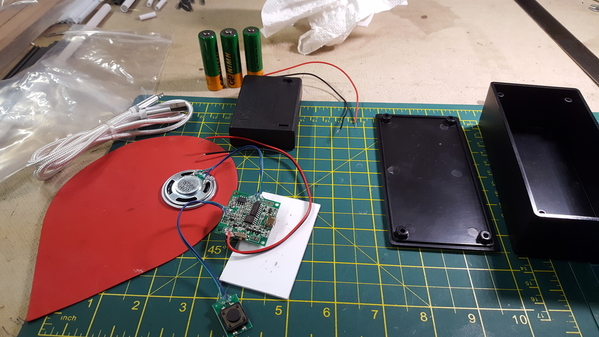
Attachments
Board screwed into place and speaker glued to silicone gasket to cut down on vibration noise. Holes drilled on other side to serve as a speaker "grille". Speaker box will be under layout module, and battery box and play button on top of layout surface. The sound clip is actually 2 minutes long, but 7 seconds is all I could load (5 mb attachment limit). Nonetheless, placing the speaker inside the box improves the loudness and sound quality due to the echoing inside.
Attachments
@SIRT posted:My tunnel modules just passed the twenty year mark.
I have admired your work as I researched my layout.
Attachments
@West Side Joe posted:
Outstanding modeling. I really like the green you chose for the columns and the framework. Rustoleum was a good choice it has the right old school look to it . Those columns were usually re- painted so many times the paint was 1/4" thick on them.
.
Attachments
Modular is the way to go. I have 15 modules all electrically isolated, but I cannot lift them to work under. I use Conch Jones connectors for electrical connections between modules. The problem is isolating the track. I have totally disconnected inter-track connections in the past and have had alignment issues, so now I use plastic rail joiners.
Attachments
@West Side Joe posted:
Hello W. Side Joe
Well, I have been following your thread pages - and I pronounce your subway-modeling work as top notch, top shelf, first class detailed and clean, neat and non- rushed, non-sloppy, construction !!!! Very impressive !!! I much enjoy it ! Regards - Joe F
"non-rushed", certainly. More than half the fun for me is the making of the thing. When it's finished, well, it's over, you know? ☺
And, by the way, Joe, your kind words about my efforts are much appreciated, especially when I look at the gems you've created. Thanks very much.
Attachments
Attachments
Looks Great. Much nicer and cleaner that the real thing.![]()
@West Side Joe posted:
Super amazingly realistic detail and precision modeling work. All uprights perfectly straight -- take away that center 3rd rail and its 100% perfect. The outside 3rd rail modeling is excellent and accurate. And the ballasted track as on early original subway lines,. Again, EXCELLENT !!
Joe F
Thanks. It's an interesting point you make about the ballasted track. When I began the first (cut and cover) module, I followed the original IRT construction. When I began the station module, I began to learn about the differences between the first contract and the Dual Contracts, including the use of a paved concrete roadbed in those stations instead of ballast, and the provision of a walkway along the BMT tunnel walls, and half-height concrete separators between adjacent tracks. So strictly speaking, ballasted track is incorrect in the Times Square station. Nonetheless, I like the way it looks. Modeller's license. ![]()
Hello W S Joe
As far as ballasted track in a Times SQ. Station, likely NOT in the 1917-18 built new Times Square "express" station for the new 1916-18 built southern extension of the old IRT West side mainline from W. 42nd Street south to South Ferry Loop.
But the original built 1904 IRT first mainline from South Ferry to Grand Central Station on what was before 1918, from 1904, an express station, and since 1918 the "Shuttle Line easterly Station" -- and continuing west under 42nd Street to the original Times Square originally LOCAL Station -- (now the west end of the shuttle) -- had ballasted track as built. So "technically" the Times Square original pre-1918 mainline station would have been ballasted, if I recall correctly. The original route from South Ferry loop, north to, and west under/across 42nd street to Broadway, and north on Broadway to Dyckman Street (and east to 149th & 3rd Ave) built between 1902 and 1905, was all ballasted track. See 1954 photo below of ballasted track at Grand Central "shuttle" station with a Deck Roof Hi-V Car with manual operated door (see end control levers). I rode these Hi-V cars on the shuttle a number of times until they were replaced by 1957 and remember the ballasted trackways. "SO", your ballasted track and "Times Square" station model has a -- ummm, authentic precedent ! I really miss the old IRT the way it was back in those long ago times !
Regards - Joe F

BELOW showing a track map and layout of the original Times Square LOCAL STATION of the original 1904 IRT first subway "mainline" where it curves from west under W. 42nd Street to north under Broadway. As originally built BEFORE the 1918 opened southerly west side extension to South Ferry.

Great info, Joe. What is the "platform of lower station" that I see on that drawing?
Your post also now explains to me why the GCT end of the shuttle is so wide: it had two island platforms when it was an express station. Thanks for that insight.
Although my 42nd St. module is trying to keep to BMT practice because my Lionel subway is an R27, I still would like a future module to follow the original 1904 IRT station practice, because that's the line I've ridden since I was a toddler in shorts getting poked by the stray ticking from the straw seats in the Lo-V cars. 😊
The wording is confusing about that 'platform" - it really was an underpass below the 4 tracks between the uptown and downtown local platforms. It ran under the east sidewalk of Broadway and is still there today. It was to be extended to W.41st street but never was done. I believe it was extended to be connected to the (beneath) the West Side IRT new Times Square express station 2 island platforms. It was made redundant as an "underpass" walkway when the shuttle was created -- but remained in use quite a number of years for the westbound (former N/B) platform passengers of the shuttle and its fare paying both area there, to get to the opposite E/B (former S/B) platform and make connection to the new southern west side IRT extension. Because the former N/B local "now shuttle" track was connected to the new northbound local track coming up north from the new Times Square Station of the new south extension mainline tunnel from South Ferry.
In later years and due to passenger rush hour speed, convenience and safety for crossing the 4 tracks, a quickly removable portable wide wooden platform was placed over the former N/B "shuttle" local track, to connect with a newly permanent concrete platform running across the other 3 "bumper ending" tracks of the shuttle at its own Times Square Station. Below are some photos from me of this arrangement.
BELOW -- LEFT - looking west along former N/B local mainline track at Times Square "shuttle" track # 4 back in 1958 showing the portable removable wooden platform placed across it where it connected to the 1918 built west side IRT Mainline local track. Stairway to upper level 1904 opened fare control area is seen still in use at end of platform
BELOW -- RIGHT - looking west in more recent time showing the basic same scene and more clearly is seen the trackway and steel framed and wooden deck portable removable platform across the former uptown local track, now shuttle track former # 4 track. In distance is seen the new 4 track lower west side mainline crossing / passing by / the curving former 1904 opened 4 track R-o-W original mainline which is now part of the shuttle segment. At left edge of photo is shuttle track # 3 which was the former N/B Mainline express track thru this station when it was part of the original 1904 opened original mainline.
ABOVE -- view north along the 1918 opened new northbound local track of the 1918 built lower west side IRT Line from South Ferry. The original northbound local track from the 1904 original built east side mainline, is seen entering westward and connecting to the west side new mainline local track under Broadway, The curving empty spaces between the curving rows of columns indicate where the original 4 tracks from the original 1904 mainline route from the east side curved to turn from W. 42nd Street, northward under Broadway and head north to Harlem and the Bronx.
regards - Joe F
Attachments
Attachments
Attachments
Beautiful! This is so nicely done. Your heart and passion is shining though this. Thank you for sharing. I’d post a hundred images if I could do this sort of magic. 👍😎
@WRW posted:Beautiful! This is so nicely done. Your heart and passion is shining though this. Thank you for sharing. I’d post a hundred images if I could do this sort of magic. 👍😎
Hello WRW --- I FULLY agree with your comments. His eye for detail and sharp crisp construction and fabrication shows well. Museum quality. Joe F
Progress has been a bit slow due to a bit of vacation in PR. Now back to work. 😁
Trackside walls finished. Supports placed for mezzanine floor.
Attachments
@West Side Joe posted:
Hello W.S JOE
E X C E L L E N T !!!!! Museum Quality work. Architectural class construction, clean and sharp painting, and detailing ! All girders are straight upright and crossbeams all level and spaced evenly. As a trained draughtsman (aka "draftsman) as well as modeler and photographer, I can truly appreciate the skill level of your work Joe F
Attachments
Joe,
Amazing detail.
As a kid in the 1960s, all I remember were the Levy’s posters in the stations.
Glen
Attachments
Attachments
@West Side Joe posted:
Is the luncheonette going to be a Nedick's?
Attachments
Attachments
Do you plan on adding some of those Chicklets vending machines which were mounted on the columns all across the NYC subway system?
That would be really cool!
Yes, I would like to give that a try. 😁
Attachments
Attachments
While the rest of their Times Square subway station luncheonette is still under construction, Sam and Fred busy themselves setting up the kitchen.
Attachments
A judisciously placed photo (such as at the left side of the kitchen) can make a tiny interior space seem much larger.
Attachments
Attachments
West Side Joe, its amazing the amount of detail you have added. I love looking at your pictures..keep up the great work! Jorge
Thank you. ☺
Hello W S Joe
I HAVE been following your recent posts and photos, and enjoying them. Especially the "subway station and mezzanine platform real estate" heh. As usual, high quality and museum caliber looking modeling work. With a great eye for attention to small details and proportional accuracy. As best as permits and can be done in O Scale for realism.
Regards - Joe F
Thank you, Joe.
Illuminated subway advertising clock added. The ad says: "This train does NOT go to Hawaii but Transocean Airlines will fly you there for $169.10".
Attachments
WS Joe - nice work as usual. Love the details.
@West Side Joe posted:
As usual, Joe -- looks great and super realistic. You have the best looking O-Scale modeled NYC Subway subway station module I have seen yet! Especially for details, sharpness, all your support columns and perfectly upright-straight and properly spaced, and everything realistically proportioned to prototype. And excellent painting. The Clock & Ad sign BOX is a major platform detail - I remember when they started putting them - first - in Manhattan stations in the early-mid 1960's. Well, ..now you have to soon start working on the next 20 stations of your "layout" !!! I have saved all your photos to a special folder on my computer
Joe F
WS Joe - Great clock and ad sign! Still waiting for the column mounted gum vending machines!
Thanks to Joe F. and Henry for the kind words. Yes, I'm thinking about how to do those vending machines, as well as other platform items.
WS Joe,
Love those gum machines!!!
All I can say is it is stunning, and in some of the shots I honestly if I didn't know it was a model would think it was real, the walls for whatever reasons kind of have that grimy look you see in real stations. I remember those gum machines and the clock signs are still there in some stations. Def looks like the #1 line in Times Square, that is for sure.
Attachments
Great hot dog heater - will be a nice add to the luncheonette. I think those dogs qualify as the jumbo variety in scale.
Attachments
Outstanding!!!
WOW WEST SIDE JOE, that looks absolutely amazing! I love to see all of the tiny details incorporated into your modular layout. Will this be on display anywhere in the future? I'm sure all of us here on OGR would love to see some in-depth videos/layout tours.
Fantastic work.
I rode the IND back in the early 1960s every day.
I was young and stupid then, and now I am old and stupid.
Are you going to run the MTH R1 set?
That was always my favorite subway set.
White Rose Hobbies: When I finish the Times Square module I'd like to take it and the tunnel module to a train show. If I am able to, I'll post the info here.
Fred: I would love to run the R-1 and the Lo-V on the layout. But right now I'm just focused on finishing this module as a showcase for the Lionel R-27. It would be super-cool if Lionel would issue those other models with opening doors. The doors are why I bought the R-27.
Update: 18 months after posting this, I broke down and bought the R-1. It really is a beautiful set.
This is amazing! I've ridden the subways in NYC a few times and you nailed the look other than it's all way too clean looking!
Lee, thank you. Yes, the subway was at times very unkempt. But I prefer to model it the way I would like to remember it. 😁
Drake's Fruit Pies, Hostess Twinkies and Tastycake Donuts available for purchase at the luncheonette.
Attachments
Attachments
Attachments
@West Side Joe posted:
Ah, Nu-Grape! I used to love getting glass bottles of it from a vending machine at a local museum near where I grew up, as a kid. Loved grape sodas ever since.
I won't derail your thread by posting my own photos, but I have a Nu-Grape sign from the 1930s on the outside wall of a country store on my own layout, out of love for the brand.
As for your earlier comment about modelling the subways as you wanted to remember them as clean, I totally get that. I think we all model something we wish had been so, and often not as it really was, but it's no less special or impressive that way.
I love your work with all this, it's quite amazing!
Thanks. I appreciate the props. I have decided to include a homeless man asking for change on my mezzanine. The only figure I could find, though, was of a homeless vet. I ordered it, but I don't want to insult any vets who might see my layout, so I don't know if I should paint over the part of his sign that mentions he's a vet. See what happens when real life intrudes upon my fairy tale world? 🙄
@West Side Joe posted:Thanks. I appreciate the props. I have decided to include a homeless man asking for change on my mezzanine. The only figure I could find, though, was of a homeless vet. I ordered it, but I don't want to insult any vets who might see my layout, so I don't know if I should paint over the part of his sign that mentions he's a vet. See what happens when real life intrudes upon my fairy tale world? 🙄
I'm a vet and it wouldn't insult me in the least. I would bet that many of those with those signs never served a day in their life anyway. I used to work in a copy shop in college, where most of the homeless folks would beg us minimum-wage workers for money, which is why I don't have much sympathy for people asking for money, to this day because of that experience.
Thanks.
@West Side Joe posted:All the years I've been in this hobby, I've always thought how nice it would be to share my efforts in a modelling publication, but I never had anything worth sharing. It finally happened. My subway layout in the October 2020 issue of Continental Modeller magazine. Hope you like it.
Nice work. Kind of surprised that Continental Modeller would be interested since it's not European prototype, but very glad it was printed. Do you have any plans to submit it to OGR or another American magazine?
Joe as stated before the level of detail you have included is incredible. The "texture" of the magazines and stacks of newspapers on the news stand definitely complete the 3D visual. What astounds me the most is your ability to fabricate and decorate the many intricate detail pieces, clock box, gum machines, hot dog roller, Jet Spray drink machine, even the kitchen.
As for the Nu-Grape and orange drink, I didn't have a favorite, the drink of choice was always spur of the moment. I loved the taste of both, enhanced by the lack of carbination bubbles.
@Mallard4468 posted:Nice work. Kind of surprised that Continental Modeller would be interested since it's not European prototype, but very glad it was printed. Do you have any plans to submit it to OGR or another American magazine?
CM has featured layouts depicting Indian, South American, North American, Caribbean and Japanese practice in addition to "continental" examples. When I finish the second module, I intend to first ask CM if they are interested in doing a sequel to the October 2020 article. Of course, it would be awesome to include it in an American publication, maybe it there's interest after I take the first two modules to a train show, which was one of the reasons I made it "portable".
Coach Joe, thanks for the kind words. I have amazed myself with the things I have scratch built on this layout. I never was a scratch builder, always looking for pre-built items. But so little exists along the lines of a NYC subway station, that it's impossible to do a half-way decent job without scratch building. I think the gum machines may be my best effort so far. They are so unique and distinctive that they can't be mistaken for anything else. The coffee urn, on the other hand, looks more like a re-purposed Star Wars droid, but I try to do the best I can, and then move on. 😊
@West Side Joe posted:CM has featured layouts depicting Indian, South American, North American, Caribbean and Japanese practice in addition to "continental" examples. When I finish the second module, I intend to first ask CM if they are interested in doing a sequel to the October 2020 article. Of course, it would be awesome to include it in an American publication, maybe it there's interest after I take the first two modules to a train show, which was one of the reasons I made it "portable".
Send an email to Allan Miller - he's always looking for material for OGR.
Thanks.
As usual - W S Joe -- what more can I saw 25 ![]() STARS out of 25 STARS -- especially so on all those many small details !!
STARS out of 25 STARS -- especially so on all those many small details !!
Regards - Joe F
Attachments
@West Side Joe posted:
-but so rewarding when you get them right like this.
Thank you.
@West Side Joe posted:
Excellent work on your part. Maybe one day I will try to do my own, maybe do the snack stand at Grand Central that was featured in the French Connection movie... and that I also was a patron of back in the day.
Yes! And maybe include figures of Popeye Doyle and Alain Charnier! 😊
Luncheonette essentially finished, except for a few figures on order to pose as customers, and the illuminated marquee, which should be a pretty interesting project in itself.
Attachments
In my youth, I used to ride the NY subways with my parents to mid-town, Coney Island, and other parts of NYC and environs (I grew up in Hoboken), and also the Hudson Tubes, which became PATH. My first job out of high school was working in the mail room at AT&T, and we’d sometimes have to deliver mail in person to staff around NYC.
Joe, your incredible modeling brings me right back to those days, especially the gum machines!
Attachments
Attachments
This belongs in the NYC Transit Museum in Brooklyn...Outstanding detail and work!
Have to say it again, amazing work.
That marquee sign makes me want to sit down and order a hamburger... along with a grape drink ![]() (aka Popeye Doyle)
(aka Popeye Doyle)
WSJ - wow you continue to do amazing work. I cannot remember how many times I have accidentally stabbed a finger with a sharp exacto blade. Good thing I am not yet on blood thinners, I still clot really well.
Where did you get those red and white fiber optic lights in photo 3? They look so cool. OOPS is guess they are wires. I don't mean to be snarky with the comment, but there are side emitting fiber optics that give the effect of neon lighting. Given the period I wonder if they would have used them.
Scouting Dad, yeah, those are wires. I have to tidy them up and put them in conduit. I just was anxious to set everything up to see how it looked with the lights on.
I'm pretty sure the luncheonettes used fluorescent lighting by the early 1960's. It was all the rage, the latest thing, "cool-white", a plus in the subway when incandescent lights added to the overwhelming heat in the subway on a hot day.
Amazing detail..you have a gift my friend...I enjoy your updates..
Thank you.
![]() AH 'the smell of the onions on the grill, the dogs, the burgers cooking.. I can't decide between a dog or a burger'... I'll have a grape nedicks though, while I'm deciding'...
AH 'the smell of the onions on the grill, the dogs, the burgers cooking.. I can't decide between a dog or a burger'... I'll have a grape nedicks though, while I'm deciding'...
Excellent work'... Joe'.. I love it'.....Great scene'....👍👌⭐✔🥤🍔🌭
@Mallard4468 posted:Do you have any plans to submit it to OGR or another American magazine?
Definitely would be interested in doing a full feature when Joe is ready. I'm easy to reach by email (in my profile) and would be delighted to help to spark more interest in subway modeling.
Allan,
If you look on the Subway forum, as well as Facebook and YouTube, you’ll see that there’s a lot of interest in subway only layouts for those of us who grew up or live in NY and other large cities.
I sold off all of my mainline rolling stock a few years ago to focus on a subway based layout and it’s a different type of build.
Wires tucked away. Waitstaff glued in place. I really liked this little project. Thanks for bearing with me.
Attachments
WSJ - I assume you know I was kidding about the red and white wires. The build is awesome. I am having all kinds of problems painting a simple soda machine the right color of red. So I really appreciate the detailing you have created.
Joe, sorry to hear about the X-acto incident. But you really nailed the luncheonette. Hit right on the head you did.
@ScoutingDad posted:WSJ - I assume you know I was kidding about the red and white wires.
Yeah, but they DID produce an interesting psychedelic effect over the luncheonette. 😂
@Allan Miller posted:Definitely would be interested in doing a full feature when Joe is ready. I'm easy to reach by email (in my profile) and would be delighted to help to spark more interest in subway modeling.
I can't wait for that collaboration.
As for sparking (so to speak) interest, I'd never even thought of a subway layout until seeing this project. I'd bet it would motivate several people to try something like this.




